Oct 22, 2024
Fried rice
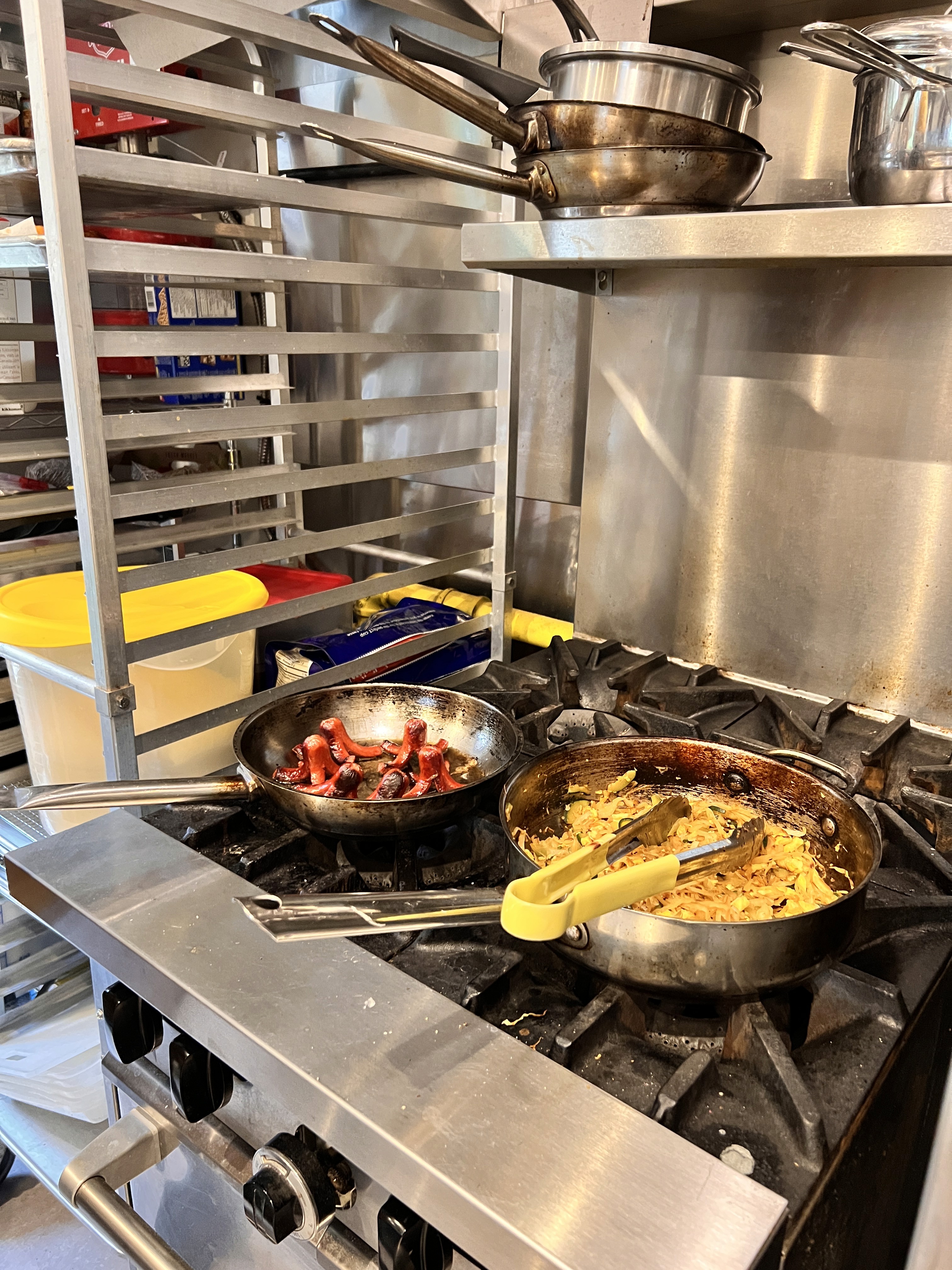
Here is a reflection on how the fried rice tournament was brought to life, as well as what I learned throughout the process.
As a disclaimer, this piece is not meant to be interpreted as a "step-by-step" guide on how to host an event. Its purpose is to illuminate how scrappy you can be when creating something, and that if you want to create something, you can just go and do it.
August 25th

On August 25th, I reached out to a couple of friends to ask if they wanted to play soccer at Central Tech Stadium.
Learning #1: I learned that I am really bad at soccer. I officially started calling it "footy" after this evening.
We decide to have post-footy dinner at Maji Curry. Luckily, this moment was captured.
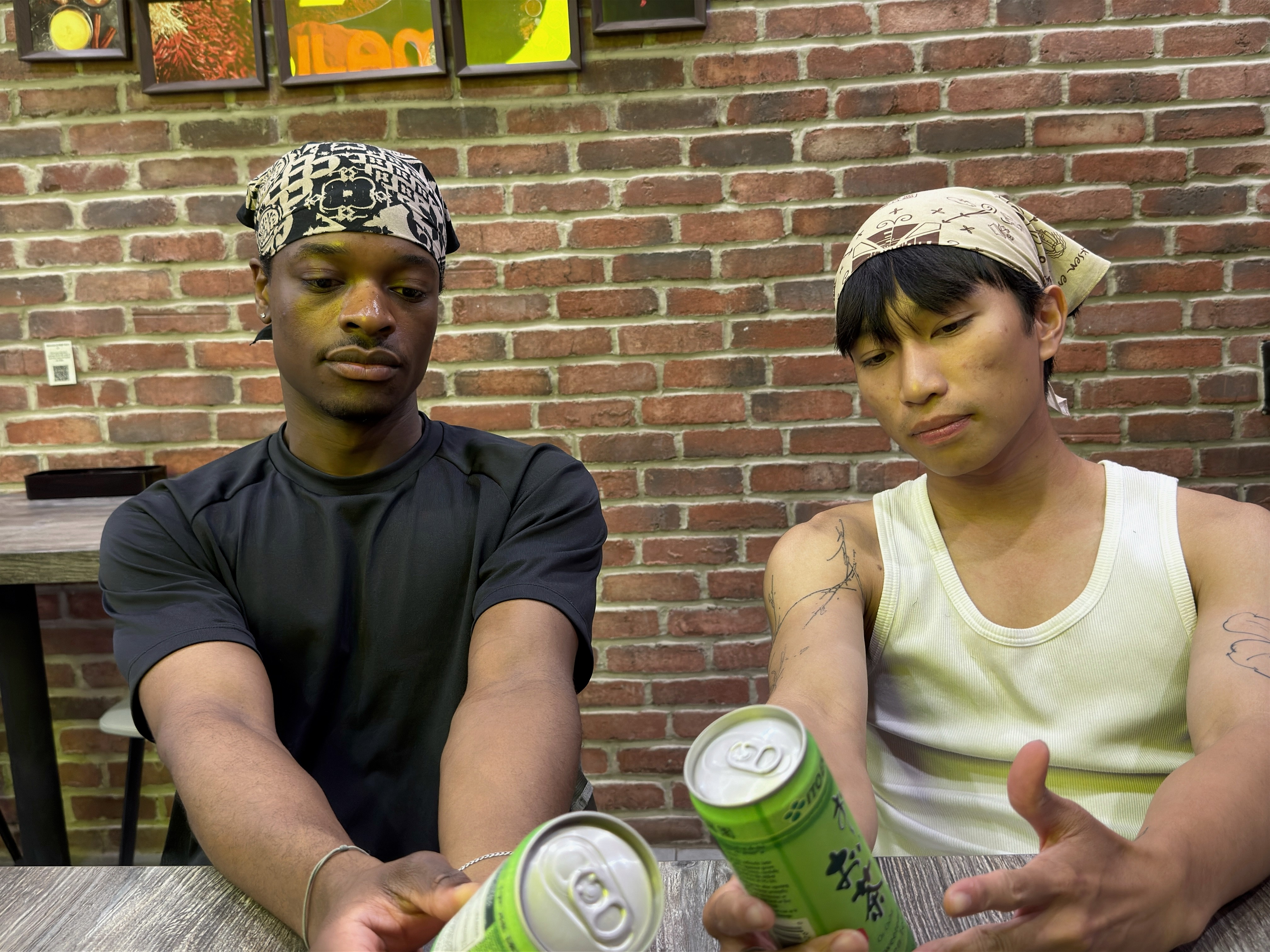
While riding off of our group dynamics and banter, we operate from a perspective of "stunts". My friends and I think a lot about the concept of a stunt and why certain projects and experiences captivate people more than others. We also think a lot about "what is something we'd have fun doing?". At some point during the dinner, I blurt out "fried rice tournament". A spontaneous spit. Not sure if it would land, just something that made me feel something. The table gets excited.
While still eating dinner and laughing over the absurdity of the idea, I begin live tweeting to gather data.

A post-footy dinner at Maji Curry was the genesis of the fried rice tournament.
August 29th
The idea lands.
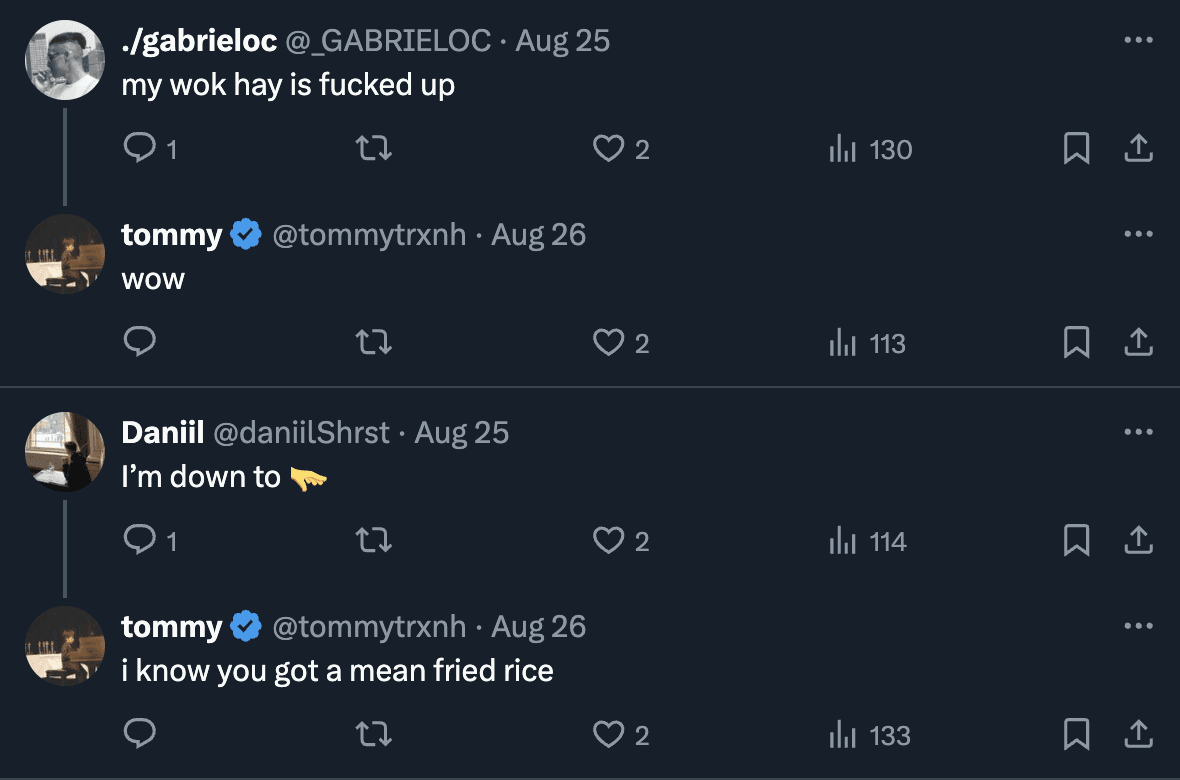


Learning #2: The people want to see a fried rice tournament.
Data is collected, the idea is a go. Now it's time to act on it.
I scour my mind for the potential venues that can afford this type of experience. Who would be down to host a fried rice tournament? Who is aligned with this type of experience? Who would be fun to work with? What space would impress the intended audience of this event?
I'm a big fan of Baldwin Street. I believe it's a beautiful street that has accomplished something really unique in the Toronto landscape. You have an abundance of amazing cafes checkered off with an abundance of incredible restaurants. The surrounding area consists of the downtown core's larger hospitals, Chinatown, Queen West, Grange Park, as well as easy access from the University of Toronto, OCAD, and TMU. It's a lovely street.
I spent the entirety of 2023 working out of cafes on this street. I became a regular at Butter & Blue and really fell in love with the space and the community it fosters. I've always wanted to work with them.
So I shot them a message.
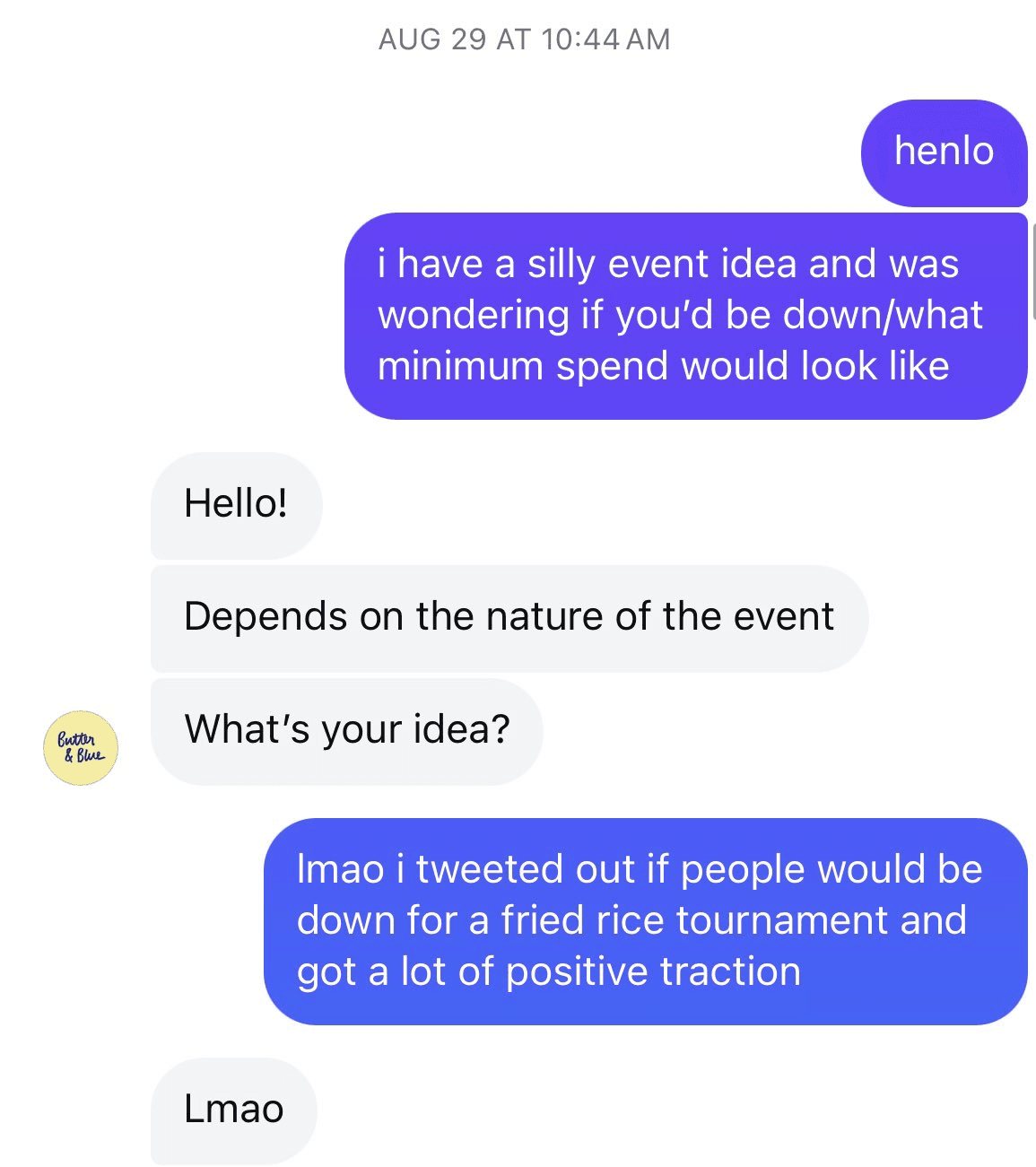
Learning #3: Just ask.
The venue is confirmed. This is the point of no return.
August 30th
I meet with Natasia, the owner of Butter & Blue. Our conversation forces me to get clear on what the concept is and what would be feasible (and not feasible) in her space. I begin to understand the parameters of the event and what the venue can afford. I also begin ideating on what would go from a conceptual standpoint and what wouldn't. Certain features begin solidifying and I begin saying no to others.
One thing that stood out from this conversation was that it wouldn't make sense for all of the contestants to cook their dishes live. They would have to come with their dishes pre-cooked, and could only be reheated at the venue.
I begin to understand that this event has to take shape around the resources that I have available. There's a difference between striving to build the best thing, and then also working with the momentum and opportunities you have in front of you. I was trying to be efficient and creative with the latter.
The idea of a fried rice tournament becomes clearer.
August 31st - October 3rd
New Builds takes over my life. I am out of commission.
October 4th
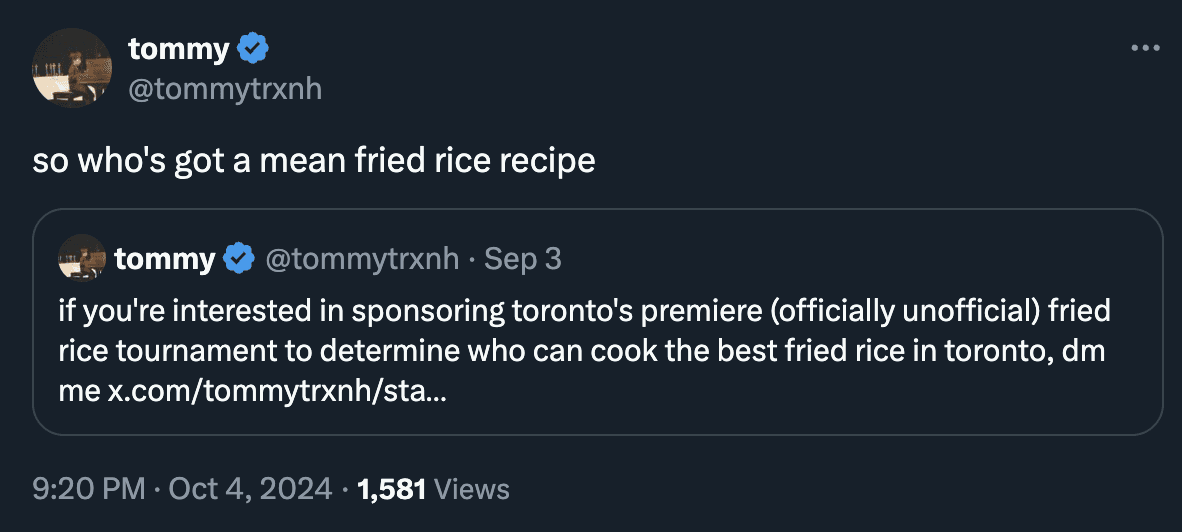
The conversation is revived. I'm back in commission after recovering from New Builds.
I ignite a creative direction conversation with my friend Malcolm, whom I deeply admire and respect. I knew that he would be able to deliver on a beautiful poster for the event. We agree to work on the poster together one evening. We end up at Java House and create the sandbox for which the poster's creative direction should live in.
October 5th
I begin collecting more data on what needs to be done to do this event right. I inquire upon several group chats of friends whom I value deeply to collect feedback and ideate on what would make this event fun and meaningful.
I begin receiving feedback that the event needs to have someone cook live for it to go. I receive the sentiment that it falls flat if we cannot see chefs preparing the actual dishes that are being served. People wanted to hear "sizzling". It clicks for me, and I realize that I already knew this all along, but the insight reveals itself once again.
Learning #4: People want to see the process.
I took this data and emailed Butter & Blue back.
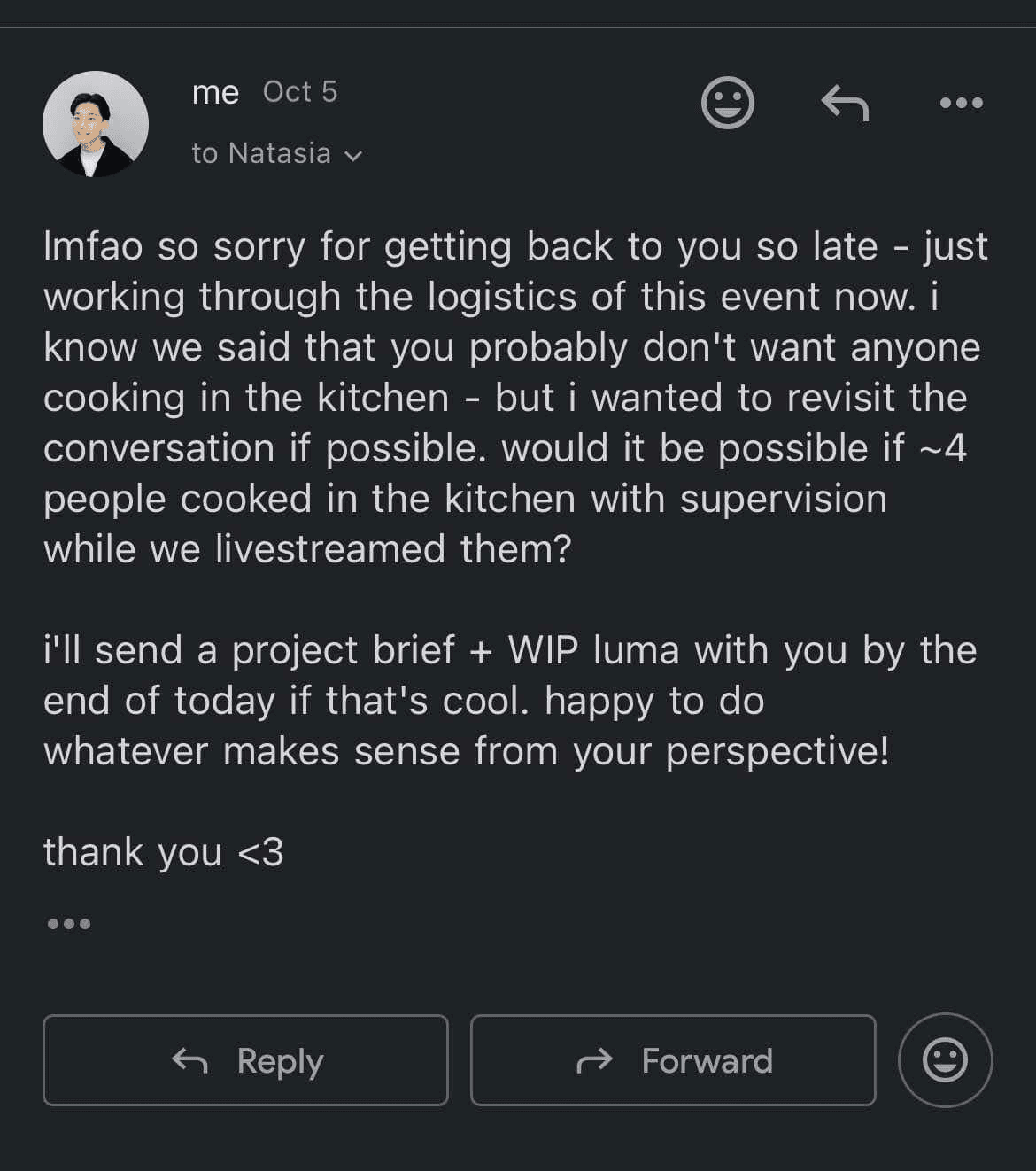
At this point, I've yet to secure sponsorship and actual funding for this project to work. With the event expenses piling up, I practice the art of "just asking".

Case Ploeg, Write Your Way Out, Ivan Zhang, and Futureland all reach out confirming that they're down to support the event.

Learning #3 (again): Just ask.
At the exact same time, I've ignited the conversation for a panel of judges. I reach out to my good friend, and tattoo artist Victor, who is also someone I really look up to and inspires me. He founded his own studio called my friends studio, where they host curated events. These experiences range from co-working sessions to cyanotype workshops to private dinners. I look up to him a lot. It was an honour to be able to receive his support and also learn from him on how this event should be conducted.

And that is how I was put into contact with Czar Evan Aboga of xenos.to, and Keanu Francisco of KUSI.
Learning #3 (again): Just ask.
Victor puts me into a group chat with the judges and we begin riffing. I start collecting data from these culinary professionals and learn from them what needs to happen for this event to work. Keanu provides extremely thorough and meaningful feedback. Our conversation also forces me to get even more clear on what this event is and what should be done in principle.

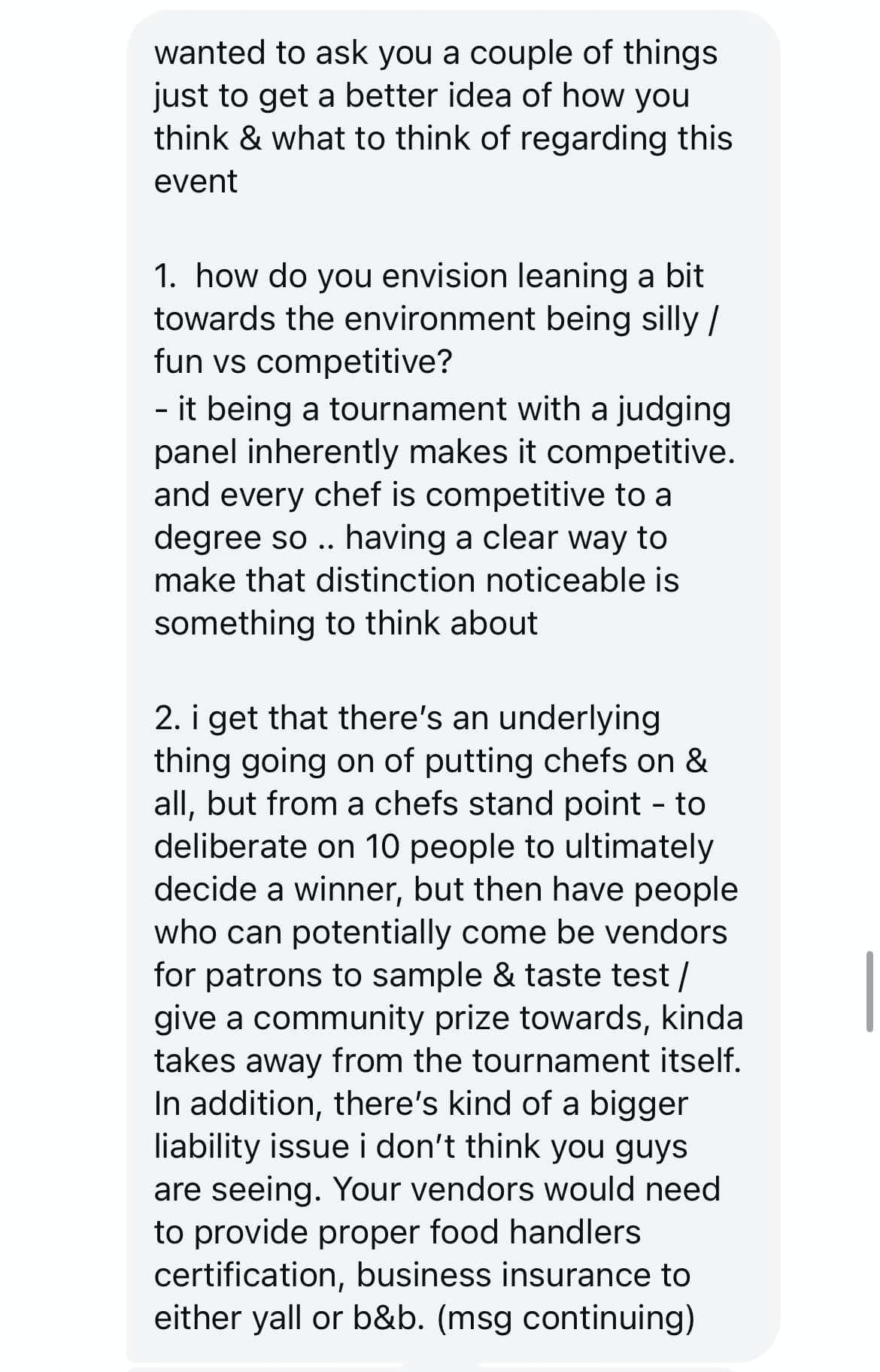
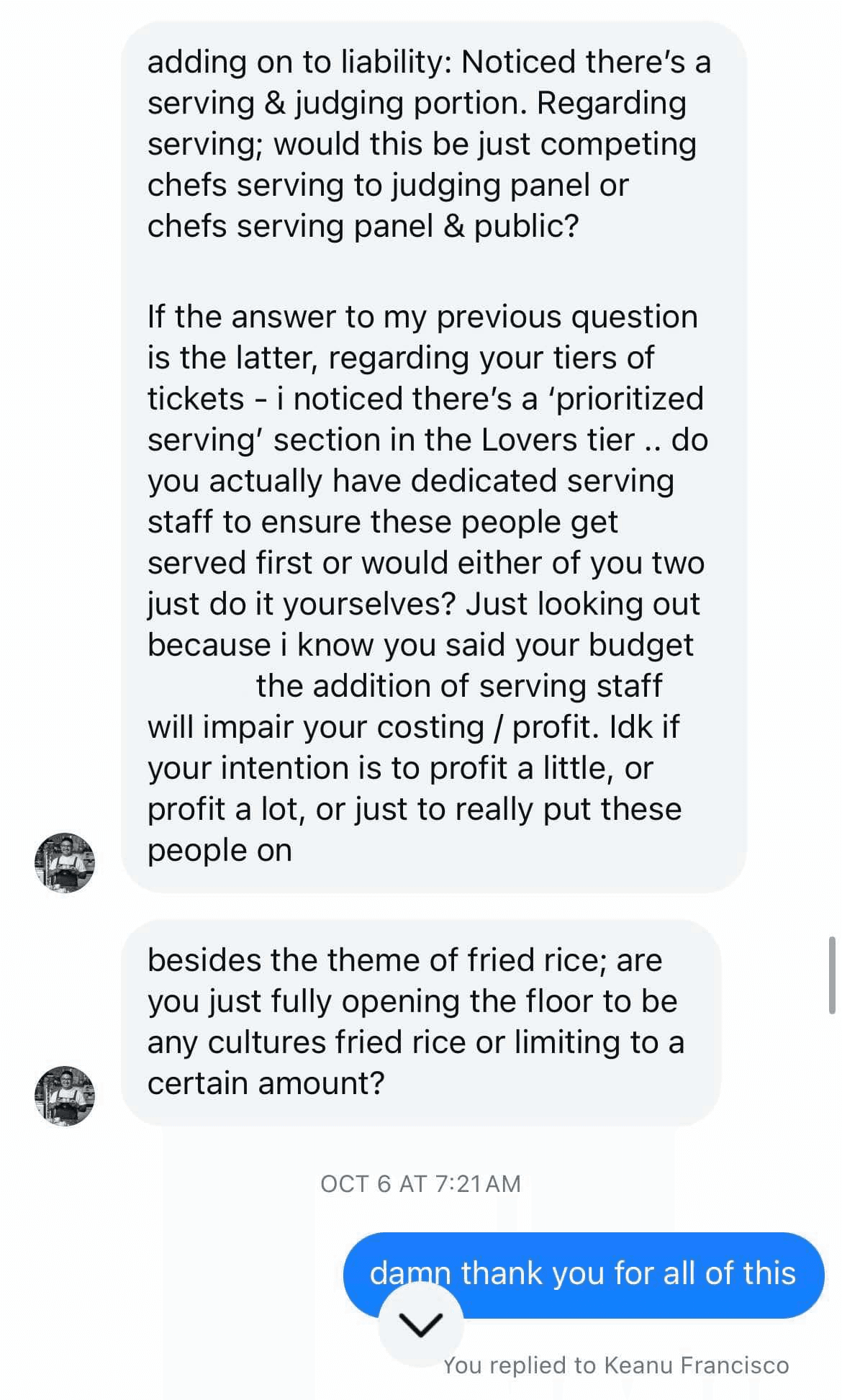
This conversation helped me a lot with refining the idea and getting clear on a lot of the logistical components behind hosting a food event where you want chefs to be serving food to the general public. Keanu illuminates a lot of factors that I hadn't even considered, and wouldn't have thought about, less I had his professional experience. I learned a lot about the Ontario Food Handlers certificate.
Learning #5: Working on anything is simple, but it can be challenging when you're exploring the concept for the first time. Patterns reveal themselves over time.
At this point we've created four tracks for this project;
The venue discussion
The judging panel
The creative direction
The sponsors
As the event name literally has "tournament" in it, it suggests a competitive nature. From my past experience, I've learned that in competitive environments, you need to have a grand prize.
Fortunately, I have an amazing and extremely talented craftsman of a friend whom I really admire and respect. I thought he would be perfect for the job. Steven joins the server.
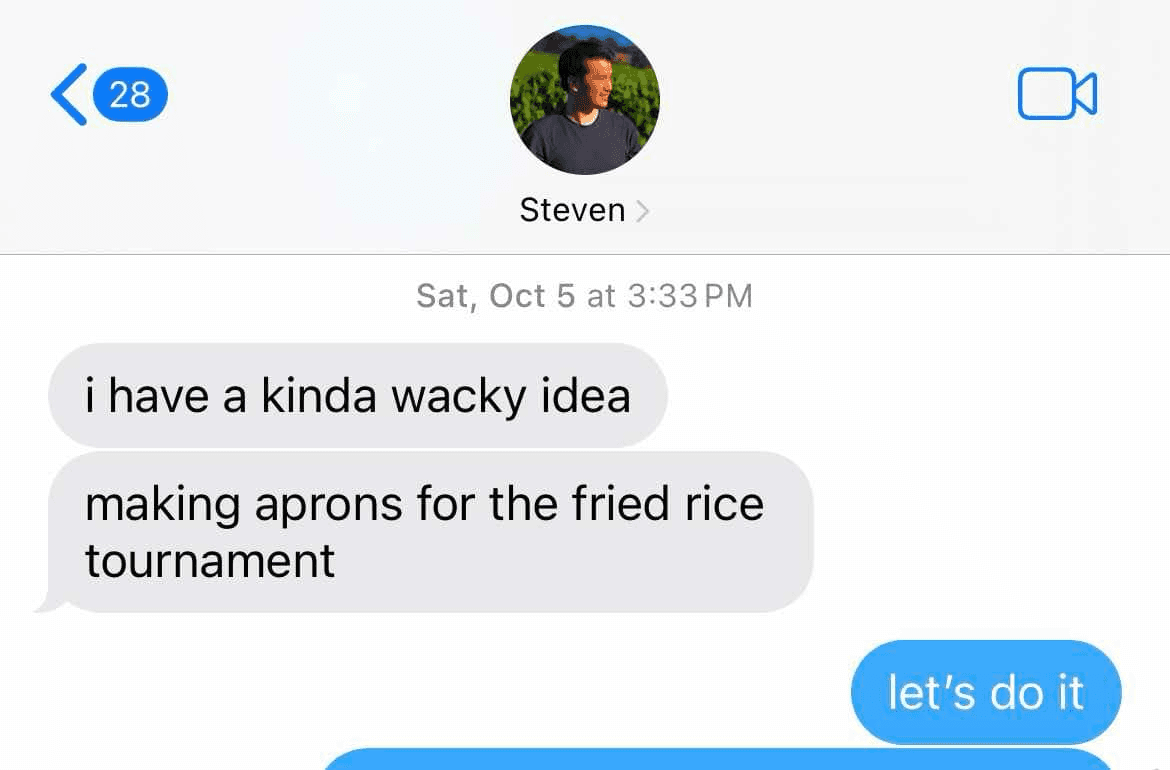
We begin exploring what the prizes of the evening would look like. This creates the fifth track, prizing.
October 6th
Butter & Blue responds to me. The idea isn't feasible given the venue constraints.
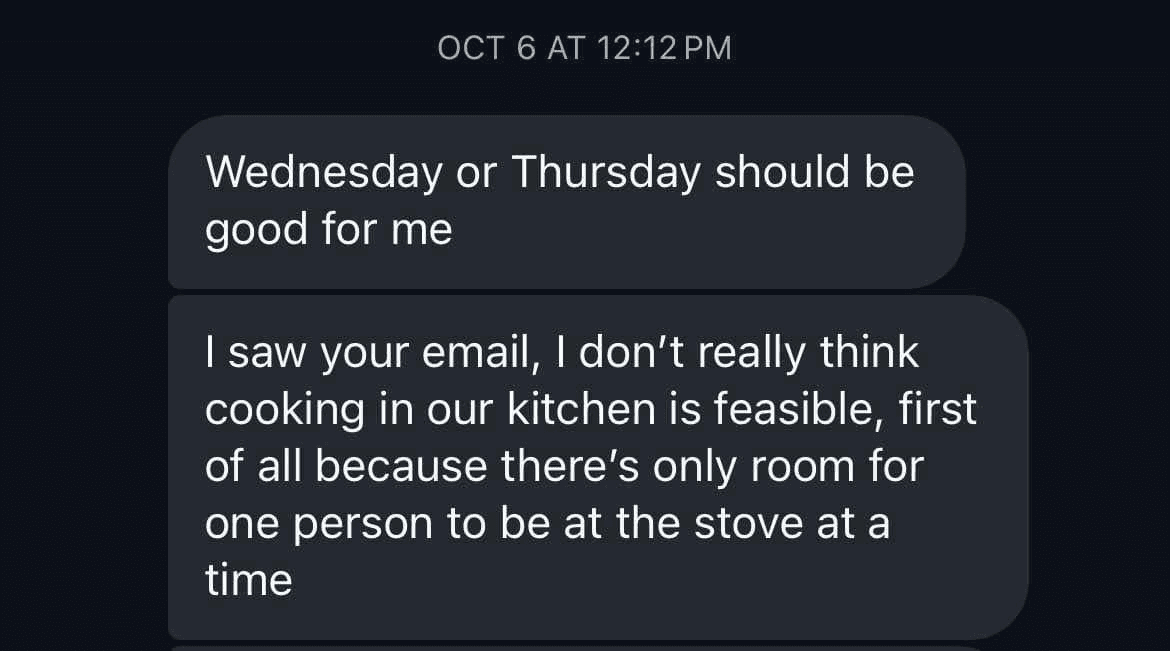
However, I understand the importance of processing feedback from the community and trying to find some middle ground that bridges worlds together. I am able to settle on one live chef cooking in the kitchen by the end of the day.

The idea of a fried rice tournament becomes clearer.
At the exact same time that the venue conversation is coming along, Malcolm creates this beautiful poster for the event.

Learning #6: My favourite way to work is to co-define sandboxes with other people that you admire and whose craft you respect, and then to co-build sandcastles. I feel like I was able to do this with Malcolm effectively.
I begin to recognize that my role in this project would end up being more on the housekeeping side, and I needed someone with the right charisma and energy to spearhead the stream and manage vibes. I recruit Michelle as someone I also admire and respect, and whom I am always confident in when it comes to her ability to MC and spread joy.
Also, on the side, I've reached out to Mike Sunday and asked if he would like to join the judging panel, because I think he's cool.

Learning #3 (again): Just ask.
Things are formalizing and becoming more concrete. I can see the different pieces coming together as well as what areas still need to be explored. I create the most powerful organizational tool that I've ever used throughout my entire life — a group chat.

This group chat would go on to host a fried rice tournament, 11 days from its inception.
October 7th
Given the competitive nature of the event as well as the speed at which it was becoming more and more of a spectacle, we fundamentally knew that it had to be live streamed. Luckily, Michelle has an expansive network for this.
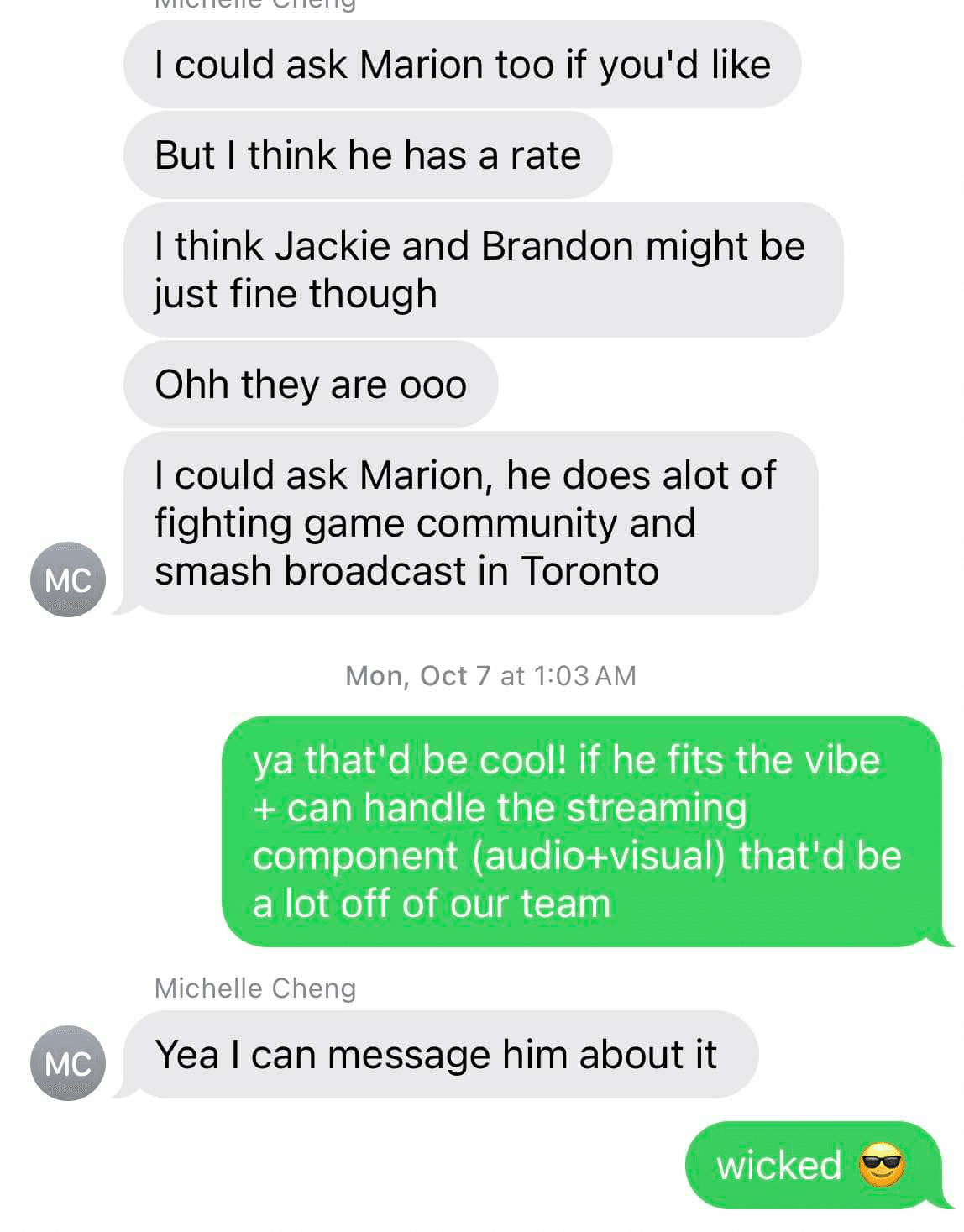

I am put into contact with Marion and Fupply, an incredible broadcasting duo, and the sixth track of live streaming comes to life.
And obviously, we need to capture photos of the evening so that it isn't fleeting. When we initially began ideating on this event, I already had strong imagery in my mind with regards to how it should be captured. It became more clear as we nailed down the venue, figured out more of the granular details, and landed on the idea of treating the event like a family gathering.
Another happy accident here was that I already knew of a photographer that would nail this vision down really well. I've admired his work from afar for the last few months and decided to pull him in.

In about 30 seconds, Deandre was recruited, and the seventh track of photography is born.
Learning #3 (again): Just ask.
October 8th
Excited, I report back to the team.
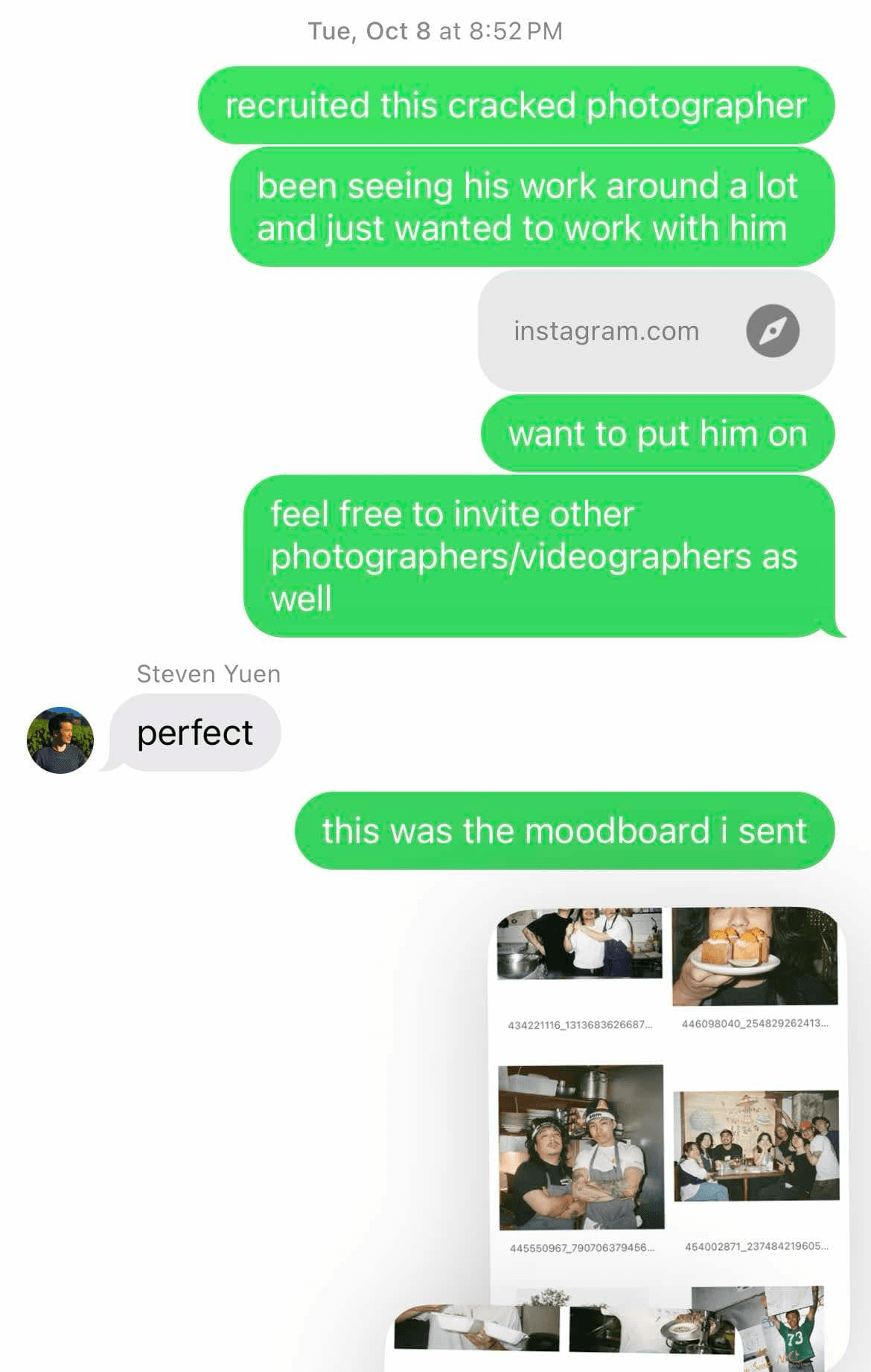
We begin working on hitting story beats. We thought there was a cool angle to begin revealing the judging panel, which also serves as a way of shouting them out and thanking them for their time. I tap on Malcolm's shoulder.
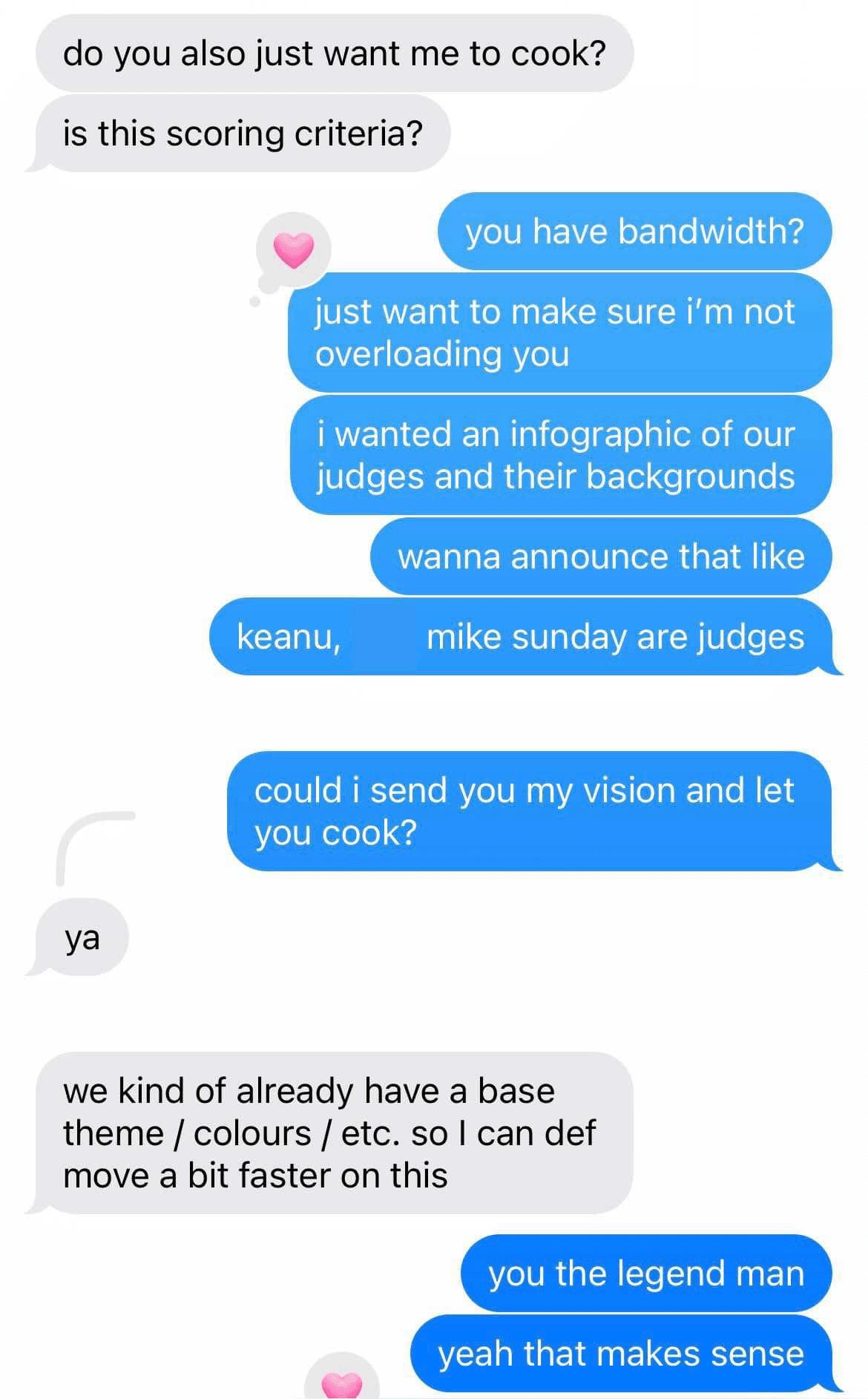

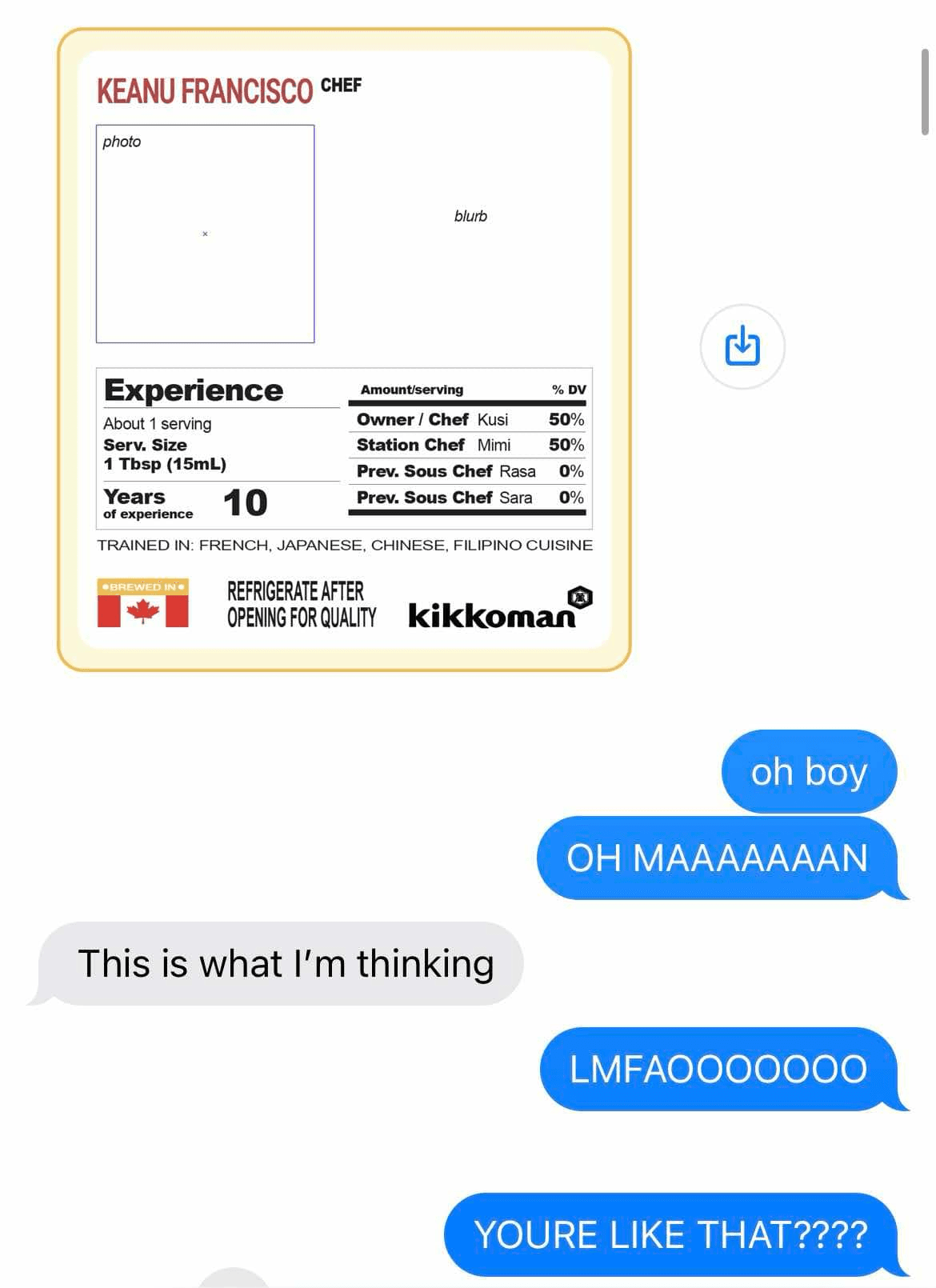

Malcolm works his magic. I'm grateful for him.
We figure out another logistical component of the event will have to be communicating to guests the allergens and dietary restrictions of the dishes that are being served. Malcolm recognizes this as an opportunity to create a custom card.
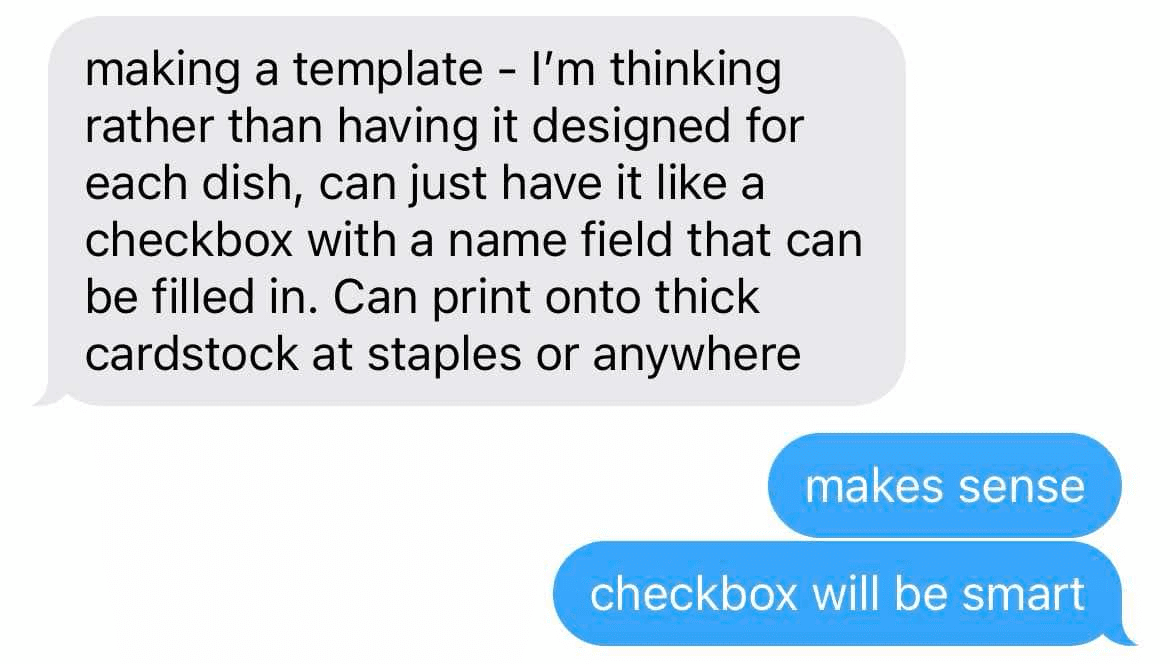
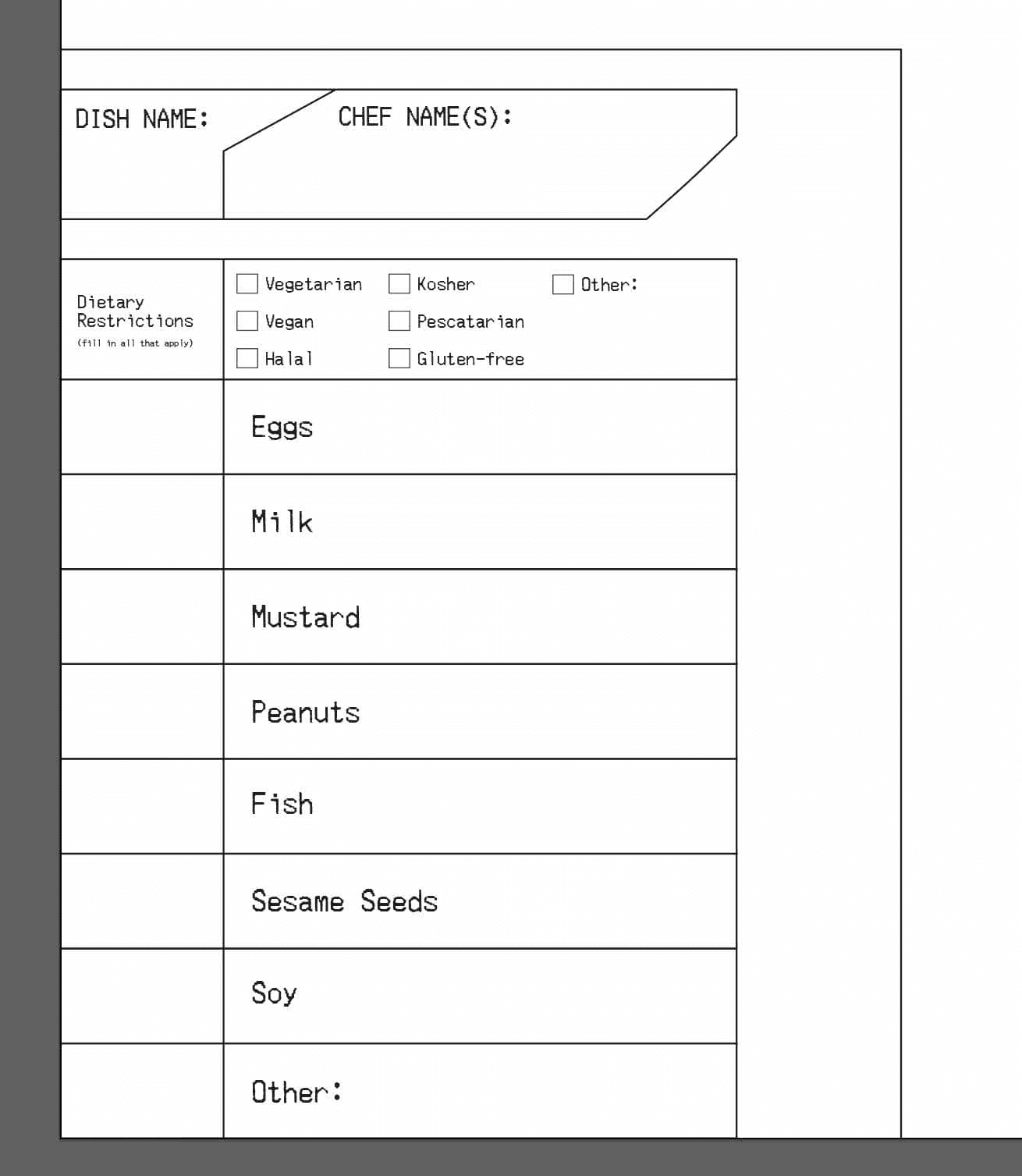
More of our bases become covered. We gain broader visibility on all of the moving pieces of this project. We're keeping tabs on important concepts and tightening the vision.
I heckin love Malcolm.
October 9th
Steven is cooking on the prizing.

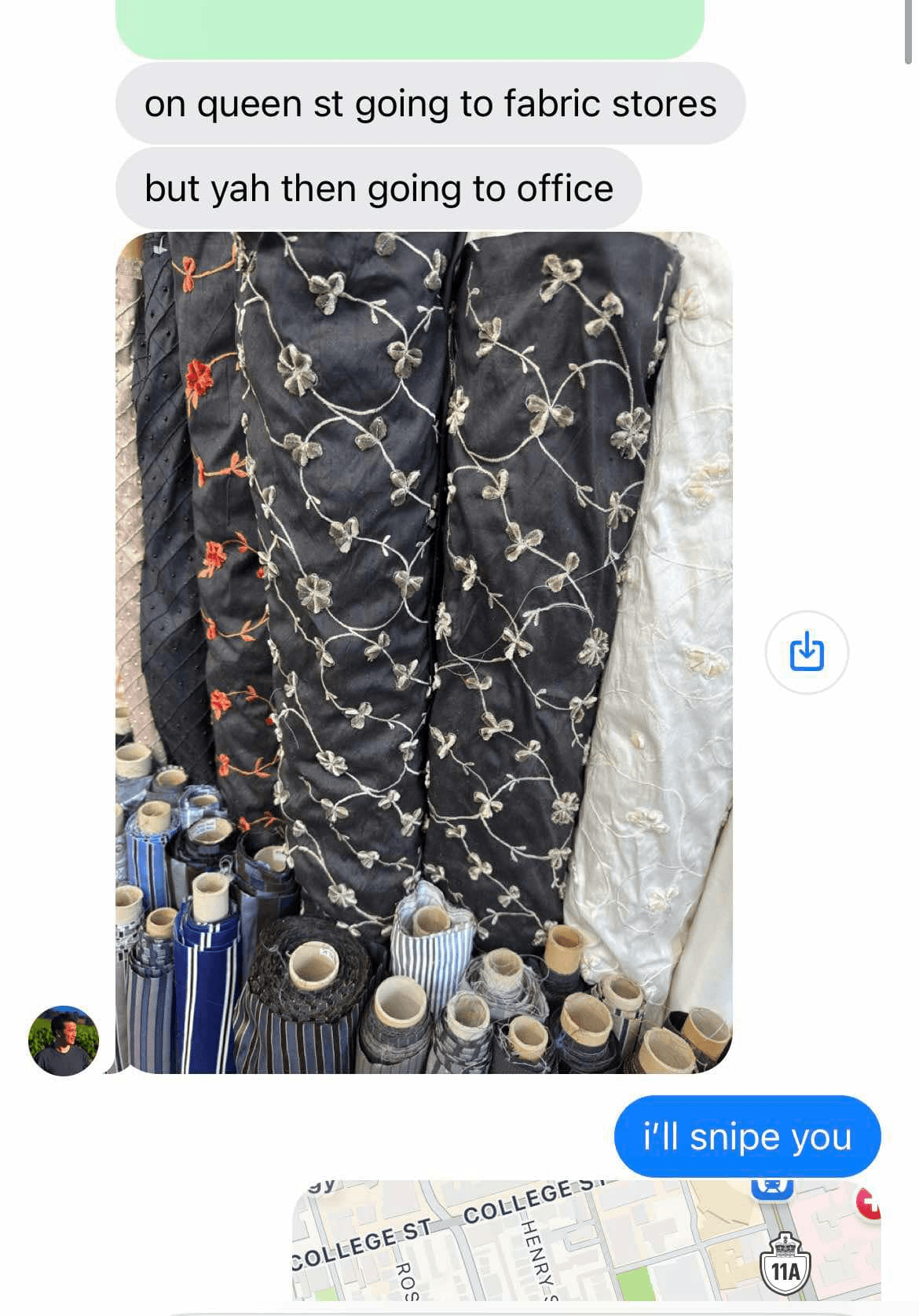
We've also recruited our good friend Ken, who has a CNC laser cutting machine. We thought it would be cool to make some gifts for our sponsors and judges.
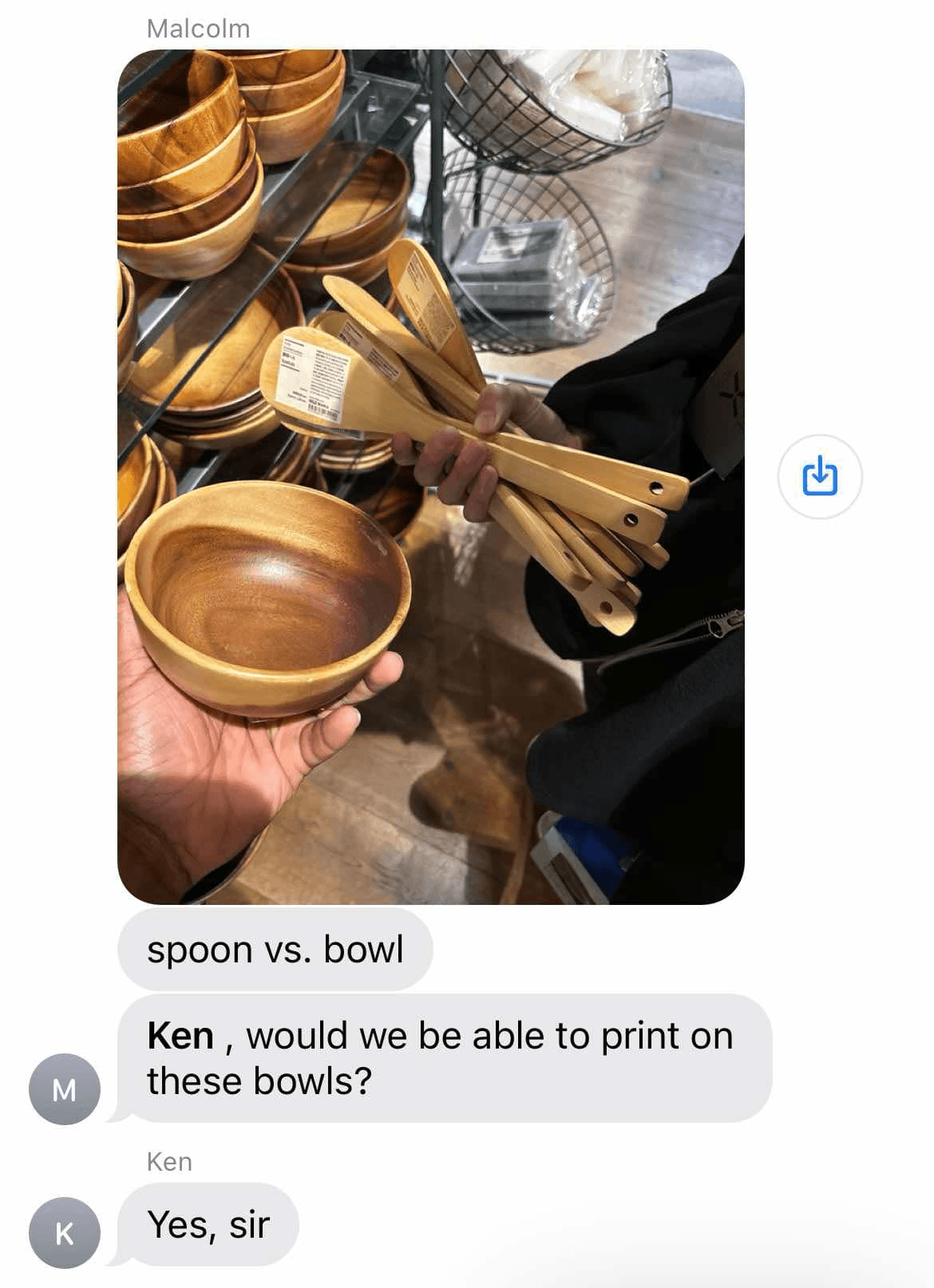

We realized that it's cool to create artifacts that tie back to the event, as they feel limited which creates meaning and value from a storytelling perspective. For these bowls, our idea was to laser print rice flowers onto them.
At this point, we're at 1 week left until the event. The speed and intensity of everything begins to accelerate. We begin navigating multiple tracks on any given day.
October 12th
Level setting for the team and delegating roles.
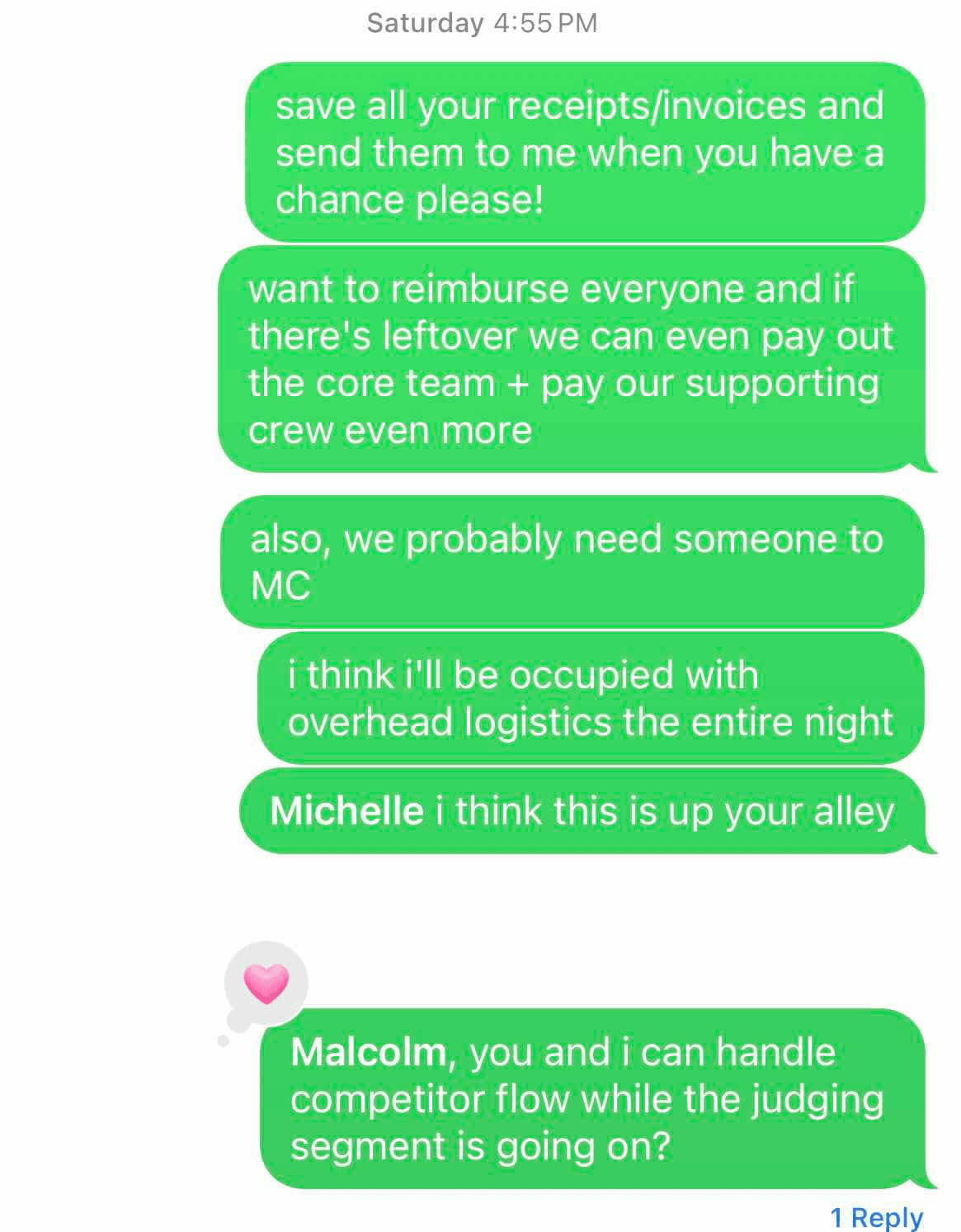

October 13th
As we are releasing the marketing assets for the judging panel, Mike Sunday announces himself and co-signs Ivan Zhang onto the panel.
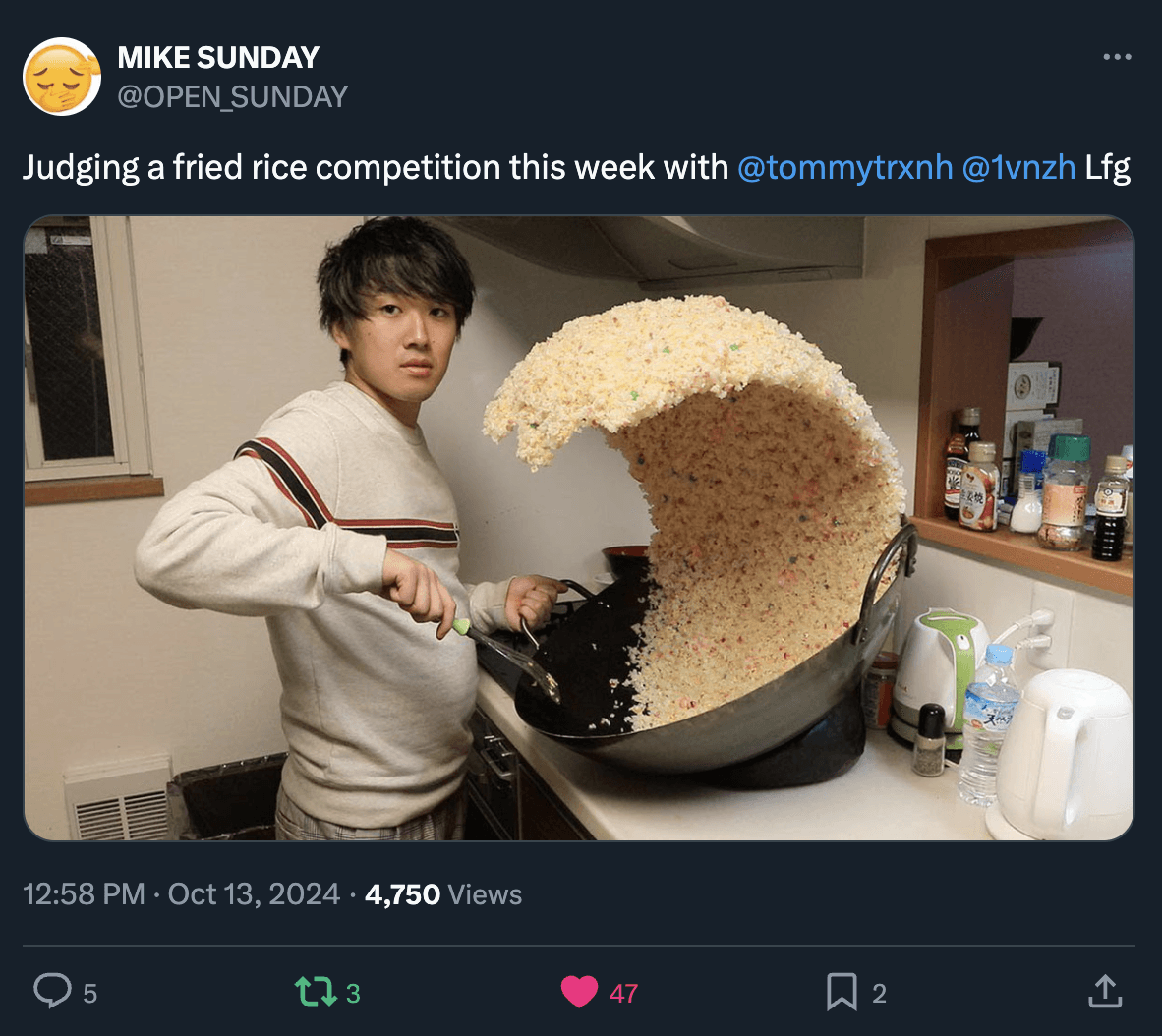

And just like that, Ivan becomes a part of the judging panel.
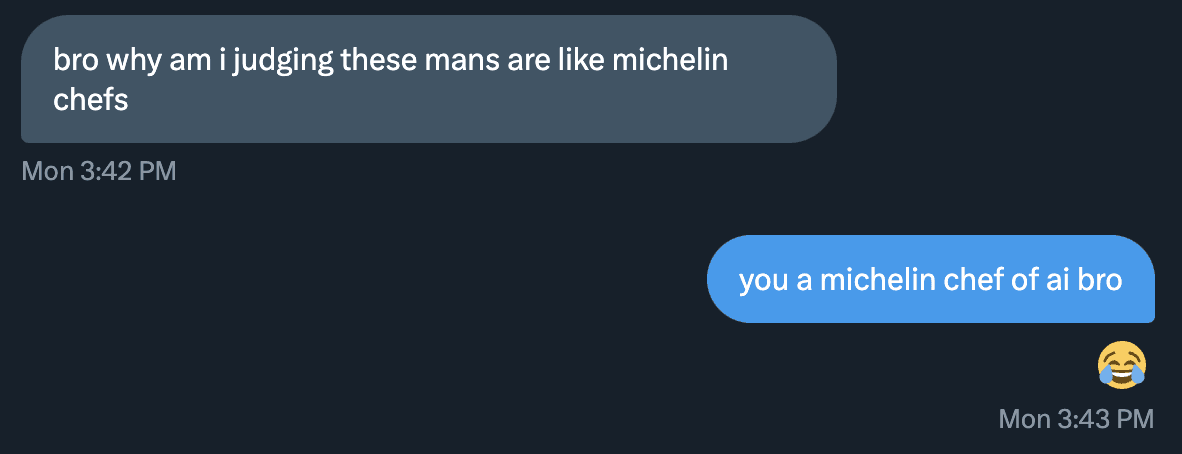

Learning #7: Be open to the vision bending as time unfolds and data is gathered. Play to the energy.
October 14th
At this point, we have about seven tracks going on at the same time.
The venue
The judging panel
The creative direction
The sponsors
The prizing
The live stream
The photographer
While all of this is going on, I am also accepting applications for chefs through a Typeform attached to the Luma event page. I am actively filtering and pseudo-interviewing them to ensure their commitment to the event as well as their overall fit, while considering things such as having an inclusive and diverse lineup.
The eighth track that begins playing out is competitor and vendor management; communicating directly with chefs, providing them a run of show, answering any questions they may have, and supporting them throughout the entire process.
After careful deliberation and direct communication with chef applicants, I am able to confirm the final competitors as well as the vendors for the event. I send an email outlining the instructions for competitors and begin illuminating what the competitive portion of the event will look like.
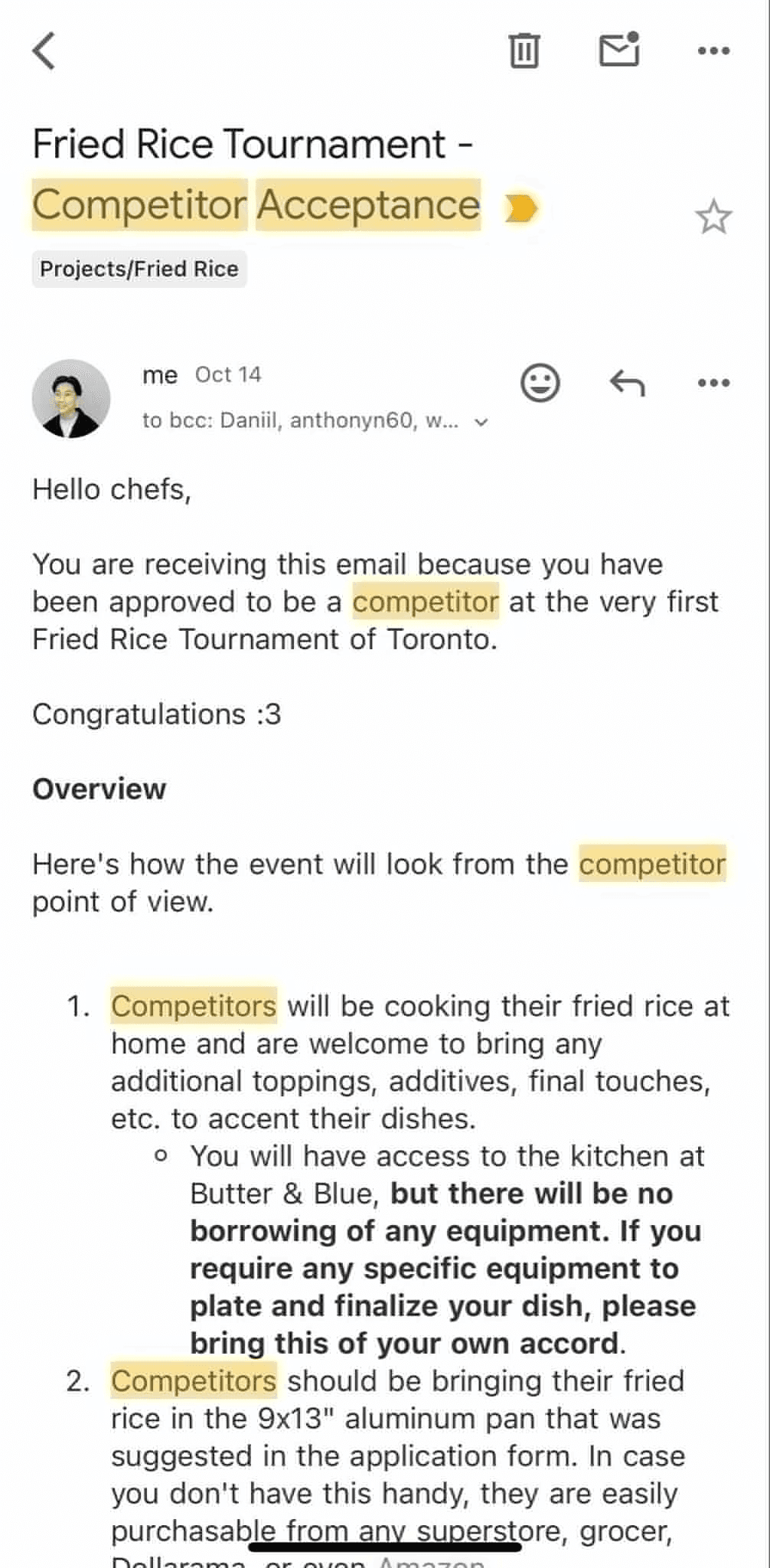
I begin doing competitor management, which entails checking in on every single competitor and addressing their questions and/or concerns as they arise.
October 15th
The next day, the vendor acceptance email goes out.
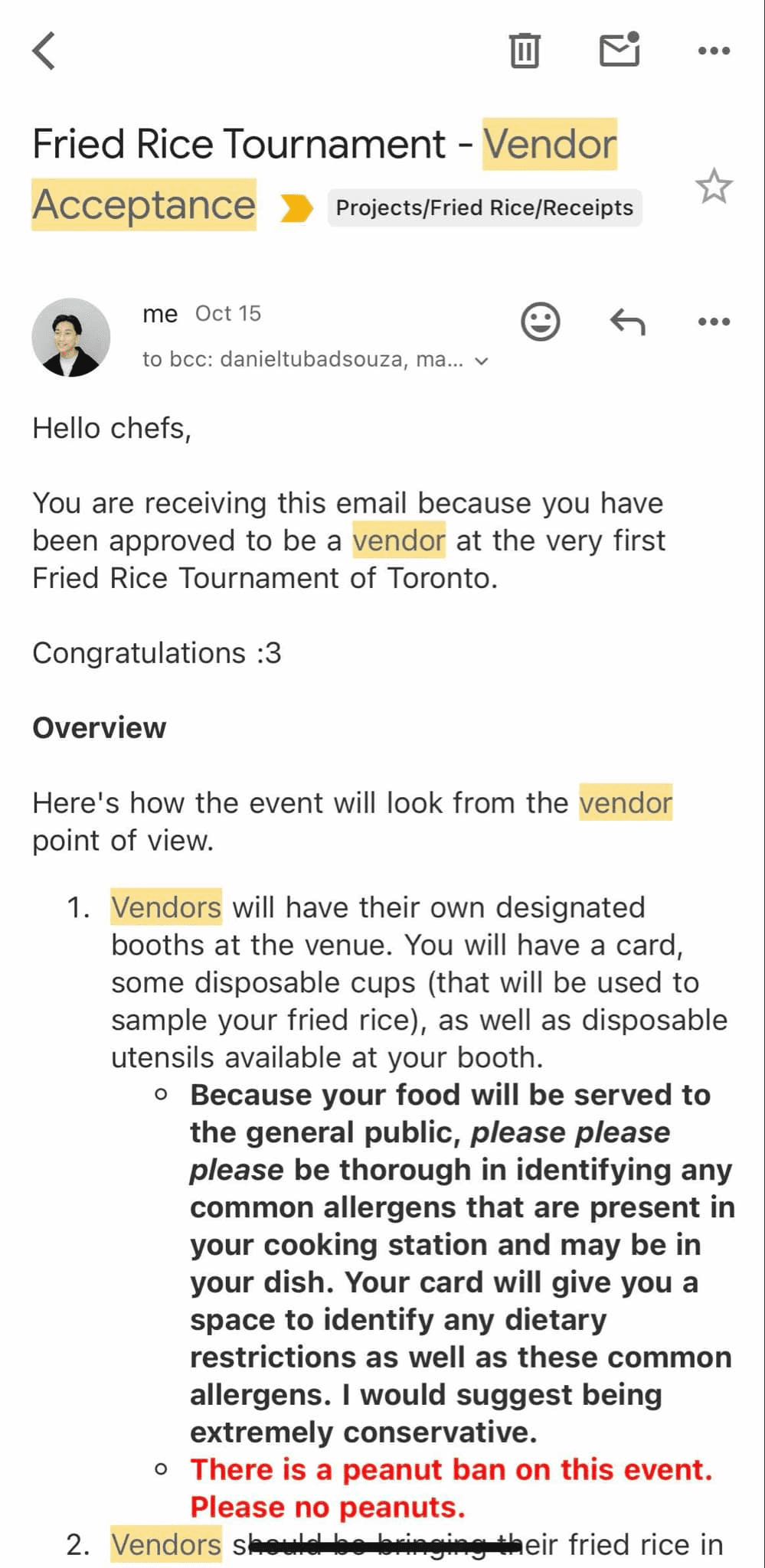
Then, I begin doing vendor management.
The custom bowls are completed and packaged (shoutout Myra for her help on this).

I also realize that I probably need somebody else to manage the gate for the event since I would be running around. Personally, I really value the first interaction that happens at any event or gathering that I go to. It really impacts the entirety of the experience, depending on how welcome I feel in that initial moment.
I usually always try to make it a point to be the person that is scanning the Luma QR code, greeting the guests upon arrival, and being that first point of contact. It's my way of personally thanking people for their time, energy, and presence. Unfortunately, I didn't think I would be able to do it this time around given how many things would be going on at once.
With that said, I seek out the warmest and kindest energy that I know of and shoot an ask.

Novia, Omar, and Flora reach out confirming that they are down for the job. I couldn't be any happier.



The organizing team's first in-person sync happens over dinner at BIWON Korean Restaurant. I order the kimchi sausage jjigae, and ask to add ramyun noodles. It costs an extra $3, but it's worth it.
We get clear on all of the remaining deliverables and go through a light run of show. The vision is becoming extensively more clear, and we have a better lay of the land. We wrap up dinner and we proceed to plaster the posters all over the city in the cold.
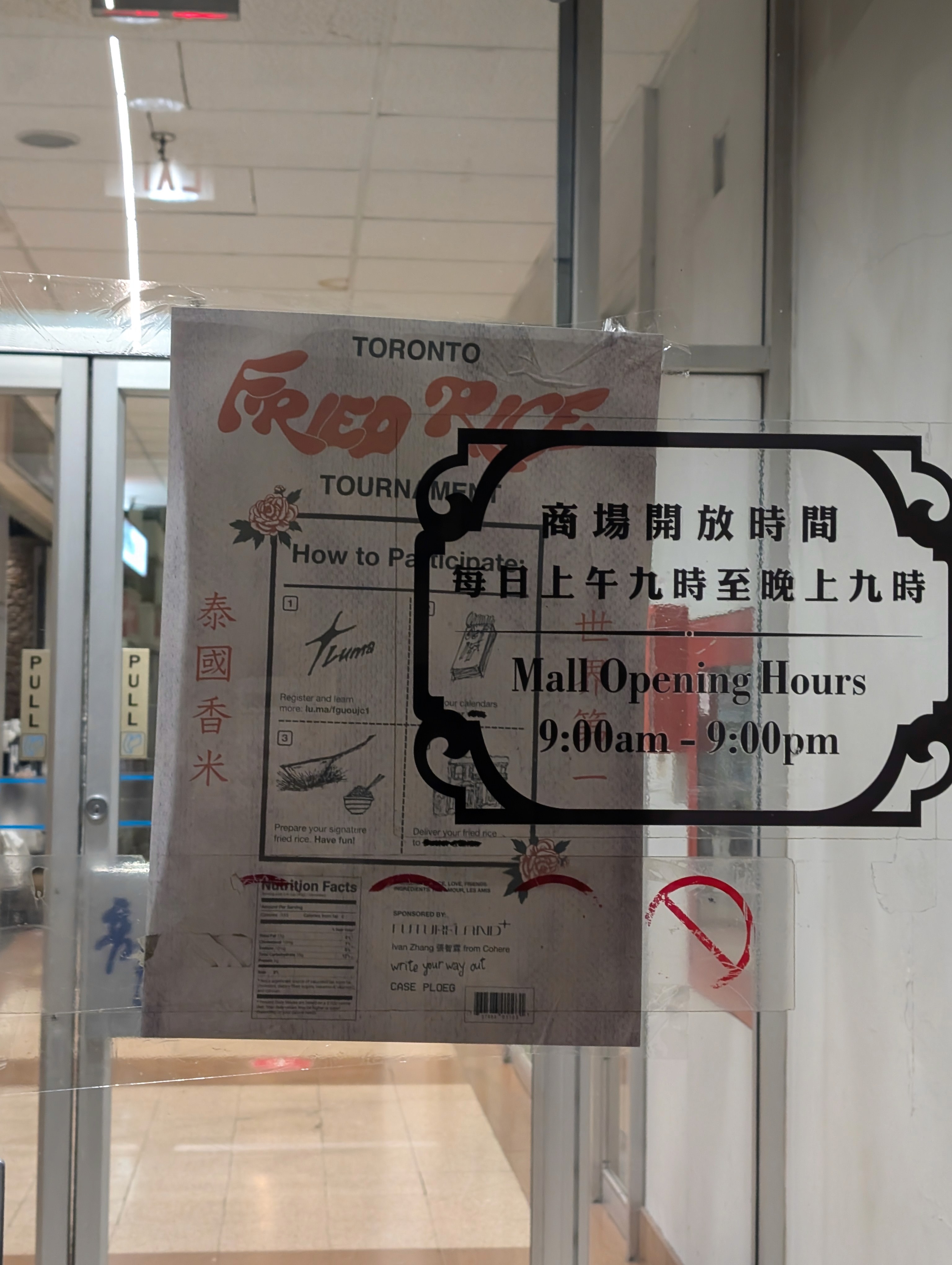
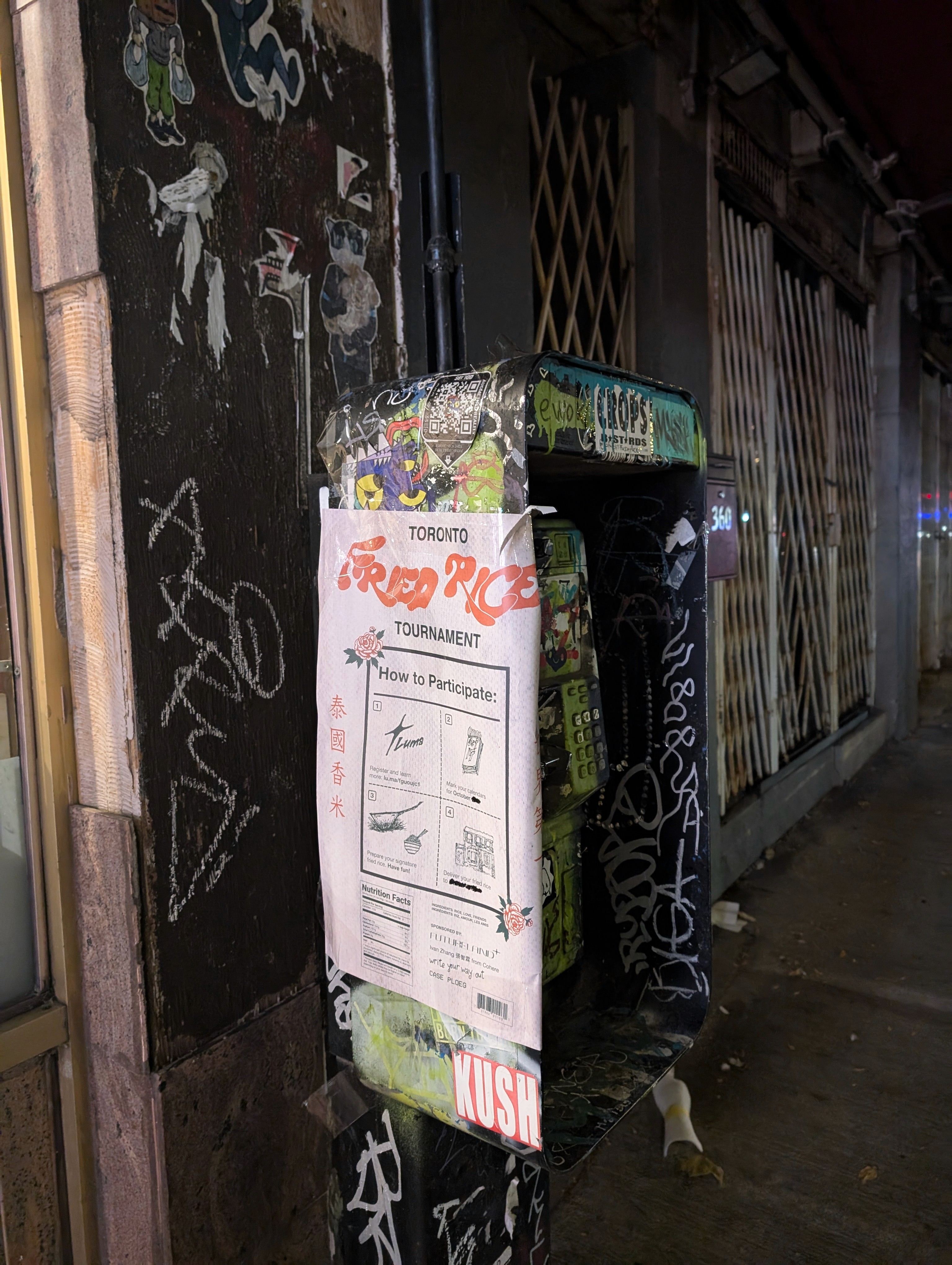


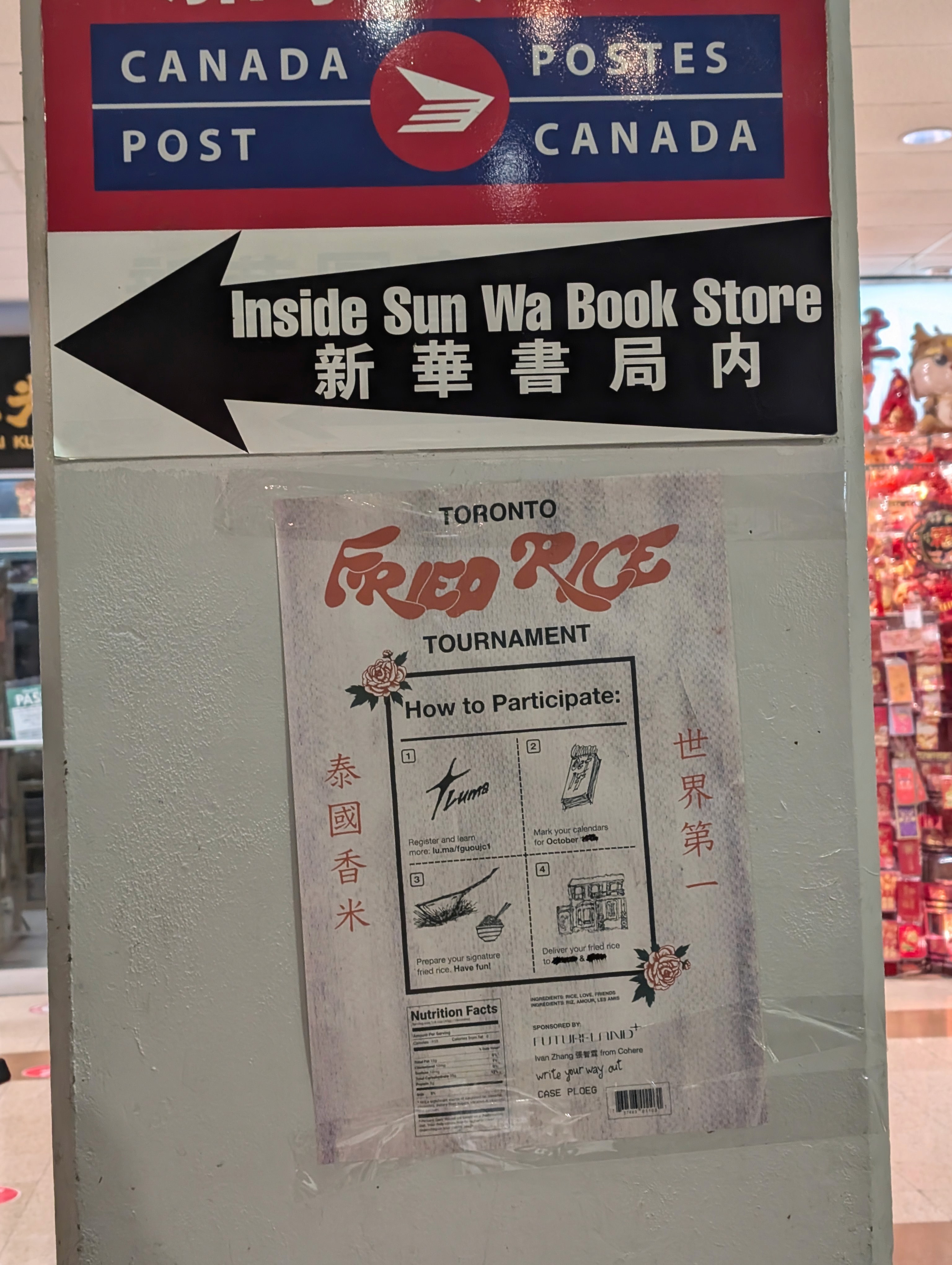

The posters have been posted. The stunt is shared on social media. We have the sandbox that the event will play within. We don't have all of the granular details mapped out, but we're prepared to figure them out together. Morale is high, and we feel confident.
October 16th
I feel at peace. All of the work that was necessary to get the ball rolling on all of the different tracks has been done. Everyone understands their role. Communication has been consistently constant. The cards are on the table.
Learning #8: I think working on projects (particularly events) feels very analogous to composing and conducting a symphony for an orchestra to play.
Planning the entire event feels like composing. Composing is envisioning all of the different sections of the orchestra. Mapping out who plays where and when.
Hosting the event feels like conducting. Conducting is letting the music unfold on its own and simply managing the dynamic in real-time. Seeing all of the different sections play at once. Guiding the harmonization.
Usually, on the day of the event, I'm kind of on auto-pilot. I'm riding off all of the tailwinds that were created to get us to this point in the first place. The composition is complete, it's just time to conduct. I trust my band, and I know they have my back. Now, my job is to just have fun.
It's usually around this point where I try to remind myself to let go of trying to achieve any specific end result. I assess everything that we've done thus far, and I'm able to generate faith that the event will go towards a direction that we will be happy about.
I'm very hopeful.
October 17th
"You're telling me a shrimp fried this rice?" — Ivan Zhang, (circa 2024)
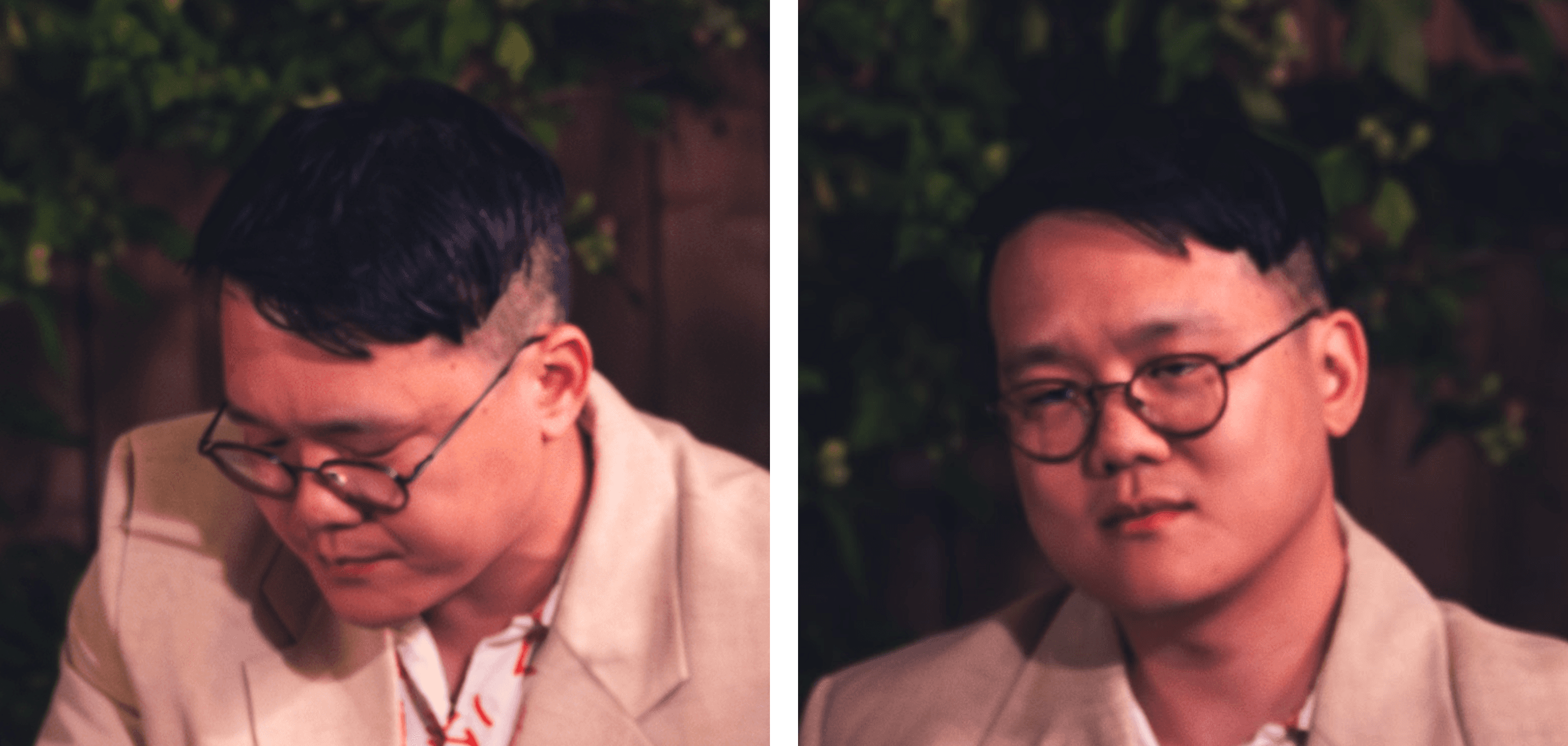
Catherine's fried rice


Felicia's fried rice
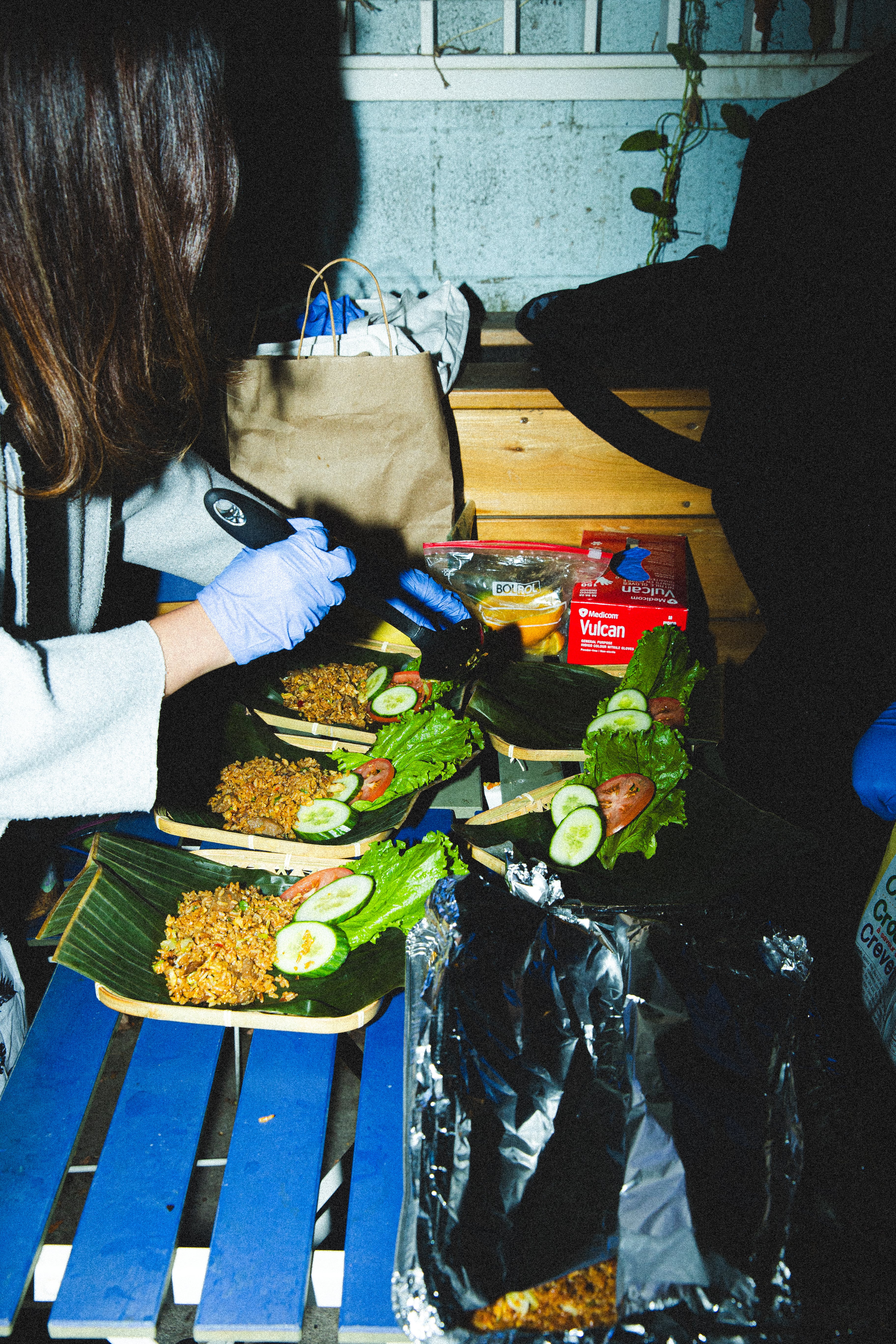
Sophia's fried rice

Nay's fried rice
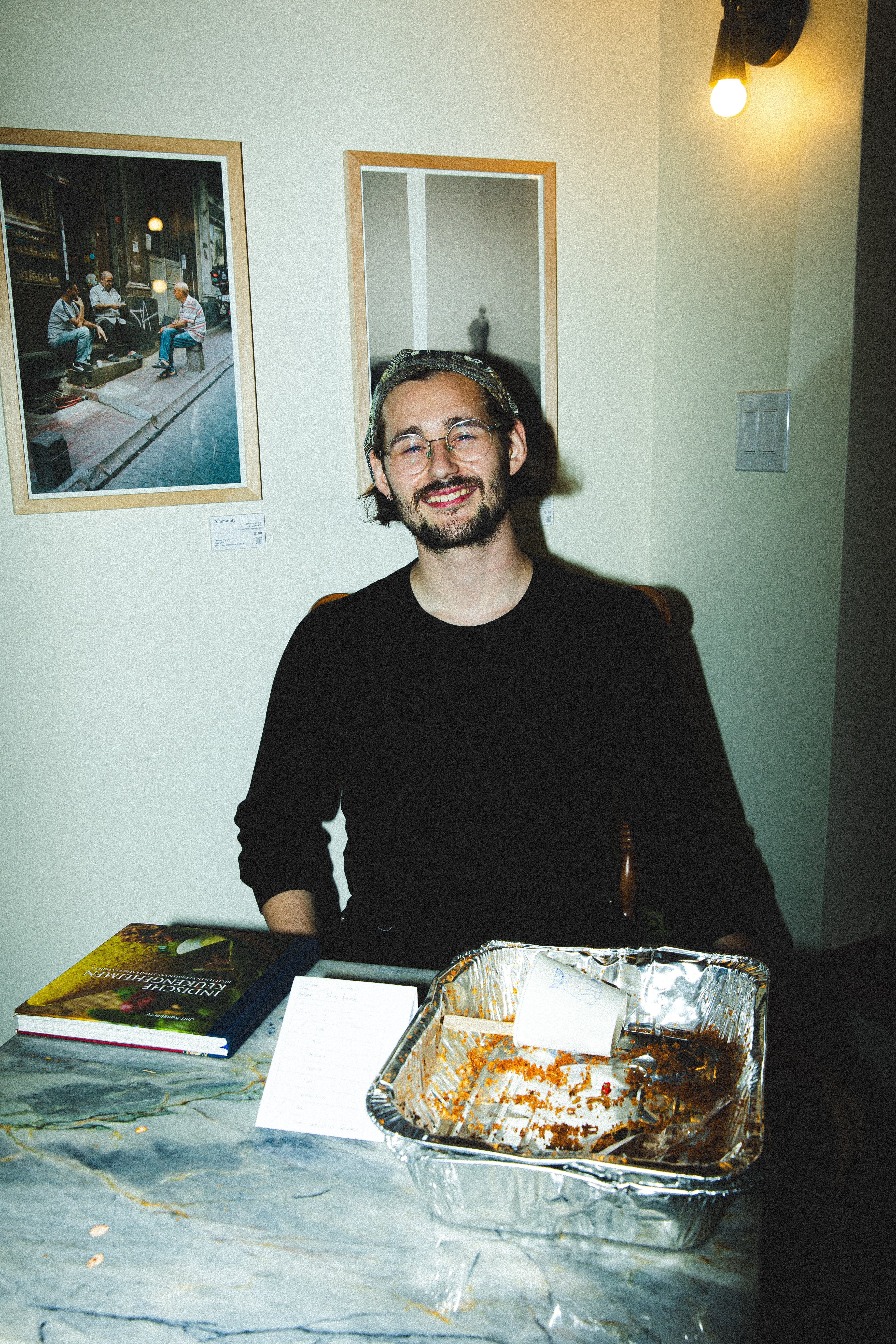
Kai's fried rice
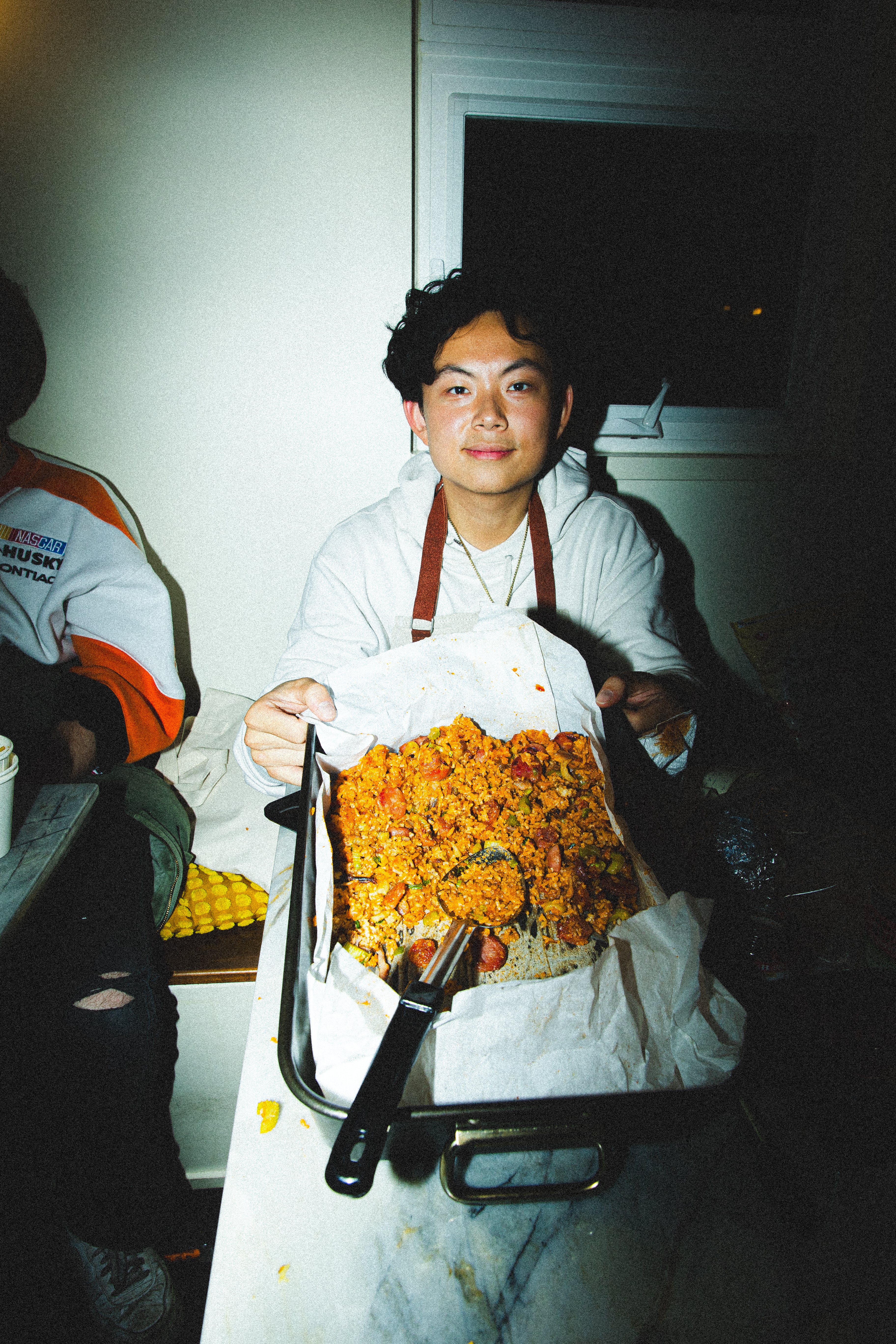
White Pill's fried rice
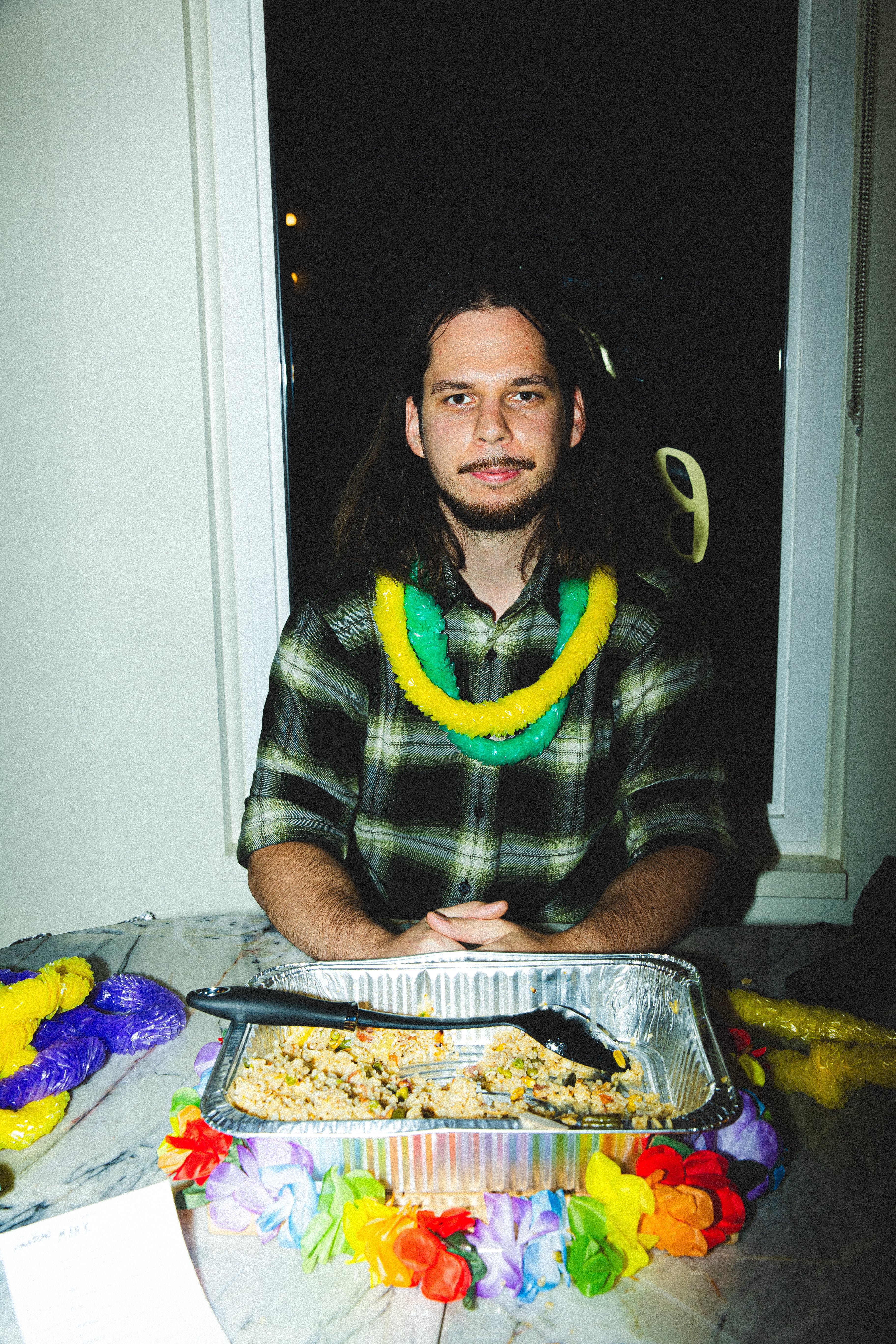
Cathy's fried rice
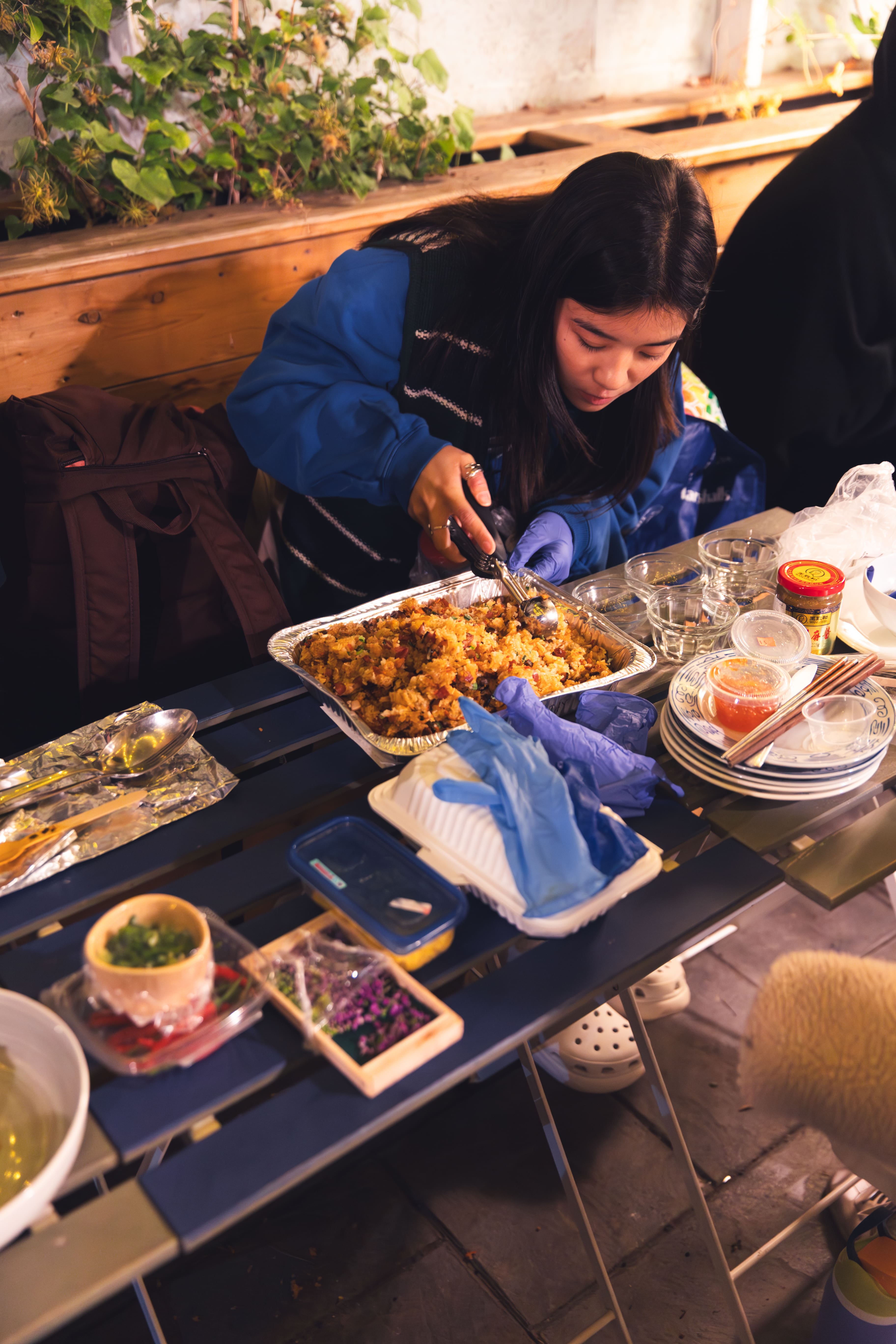
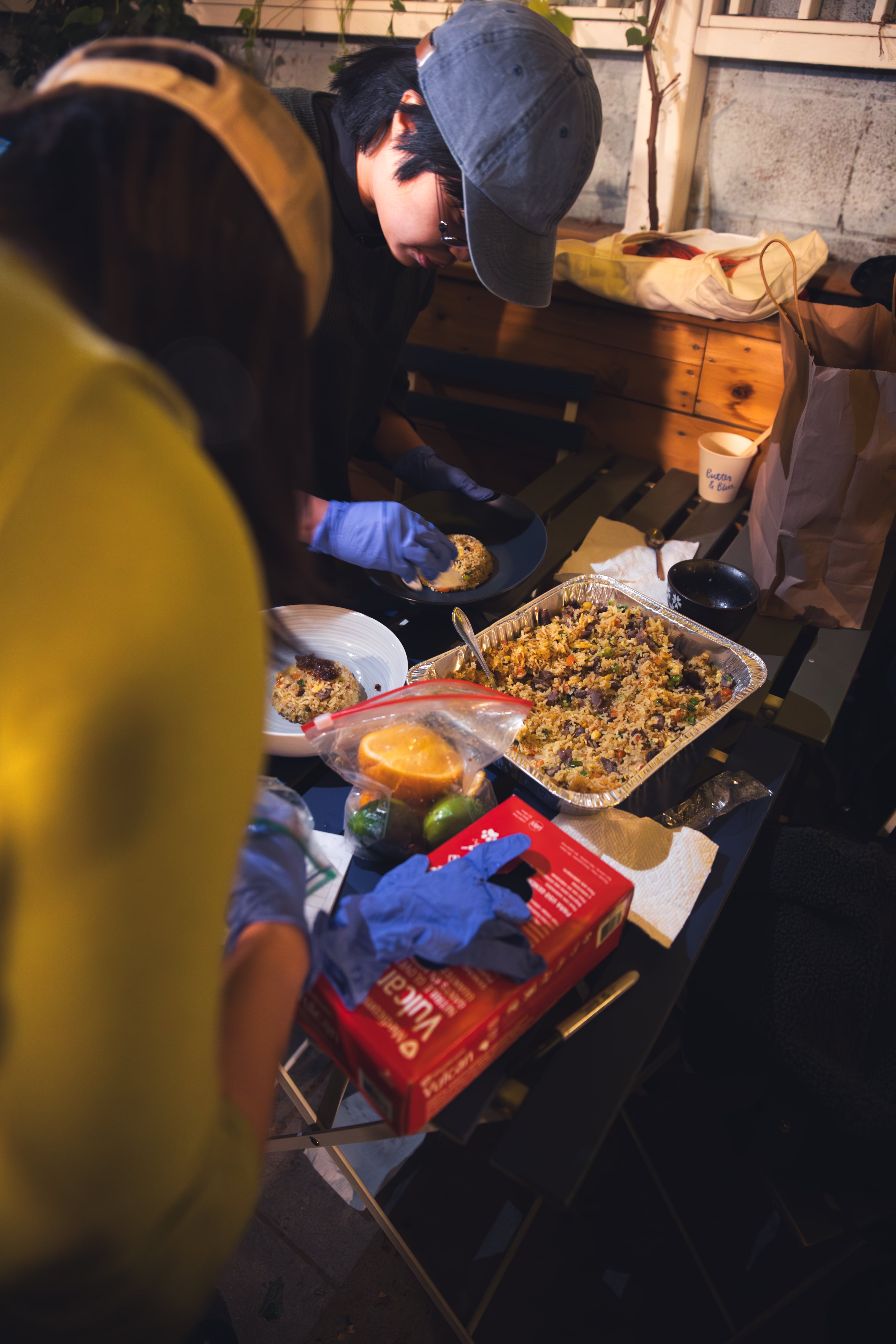


Anam, the grand champion of the fried rice tournament, receiving the fried rice apron, custom made by Steven.
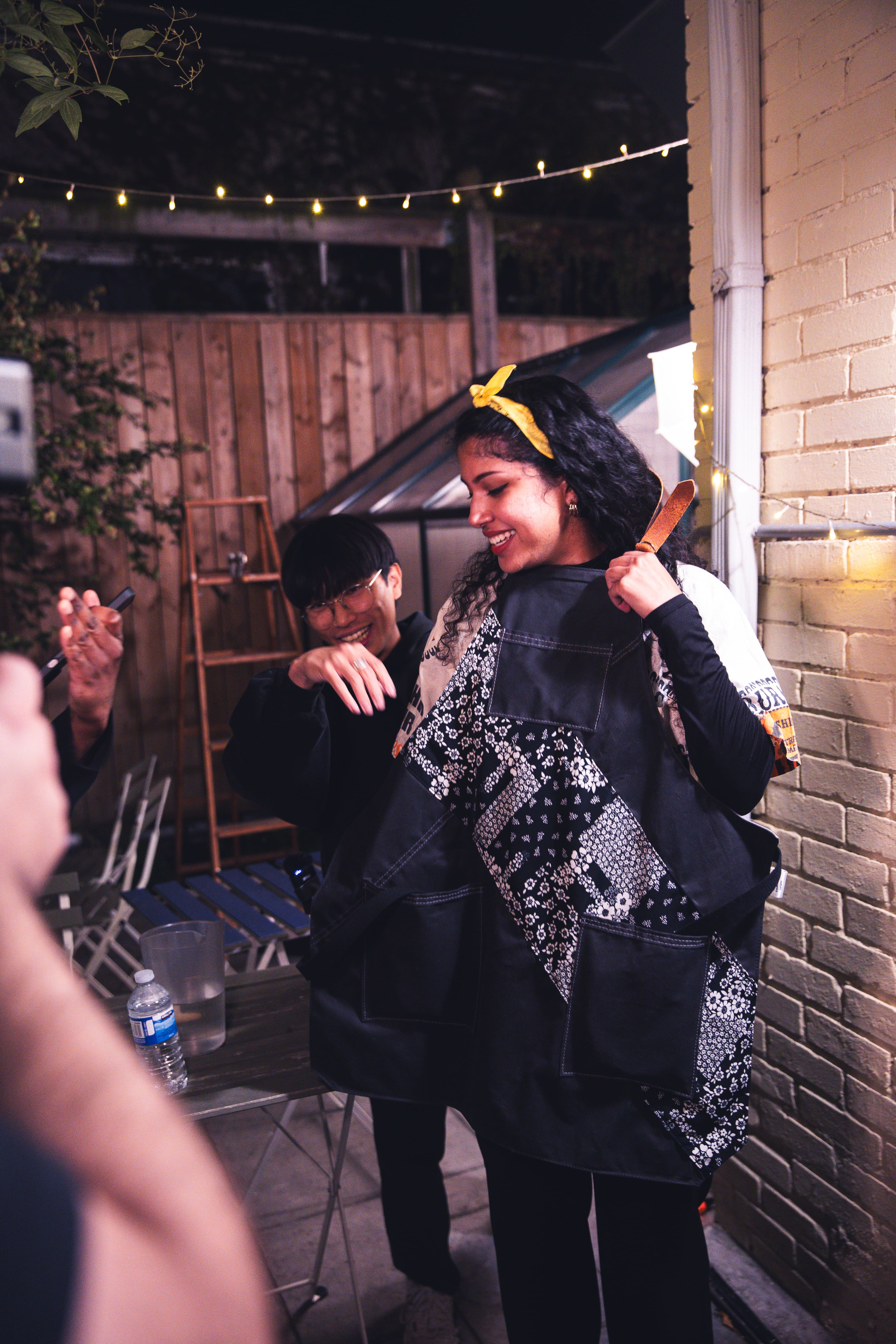






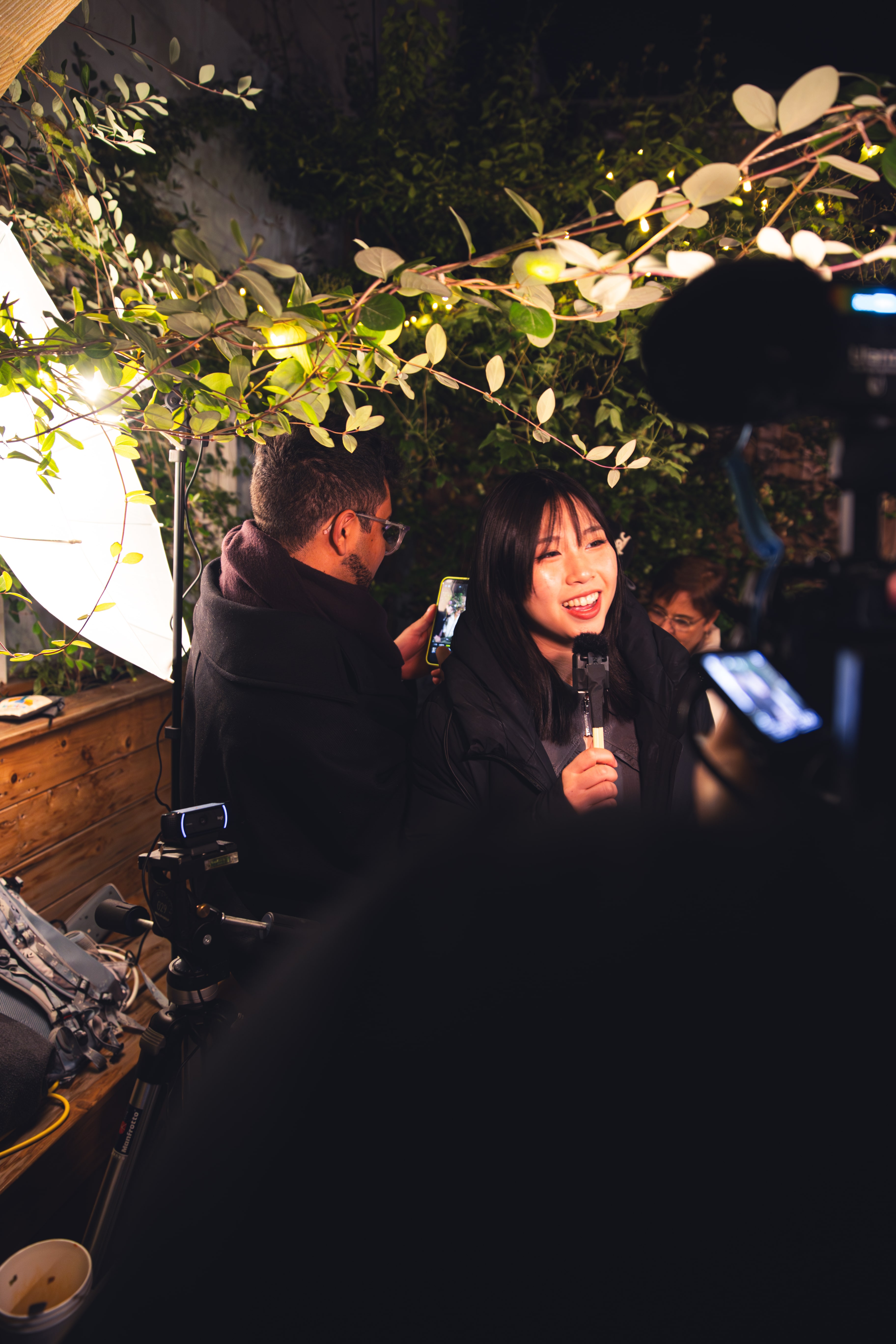
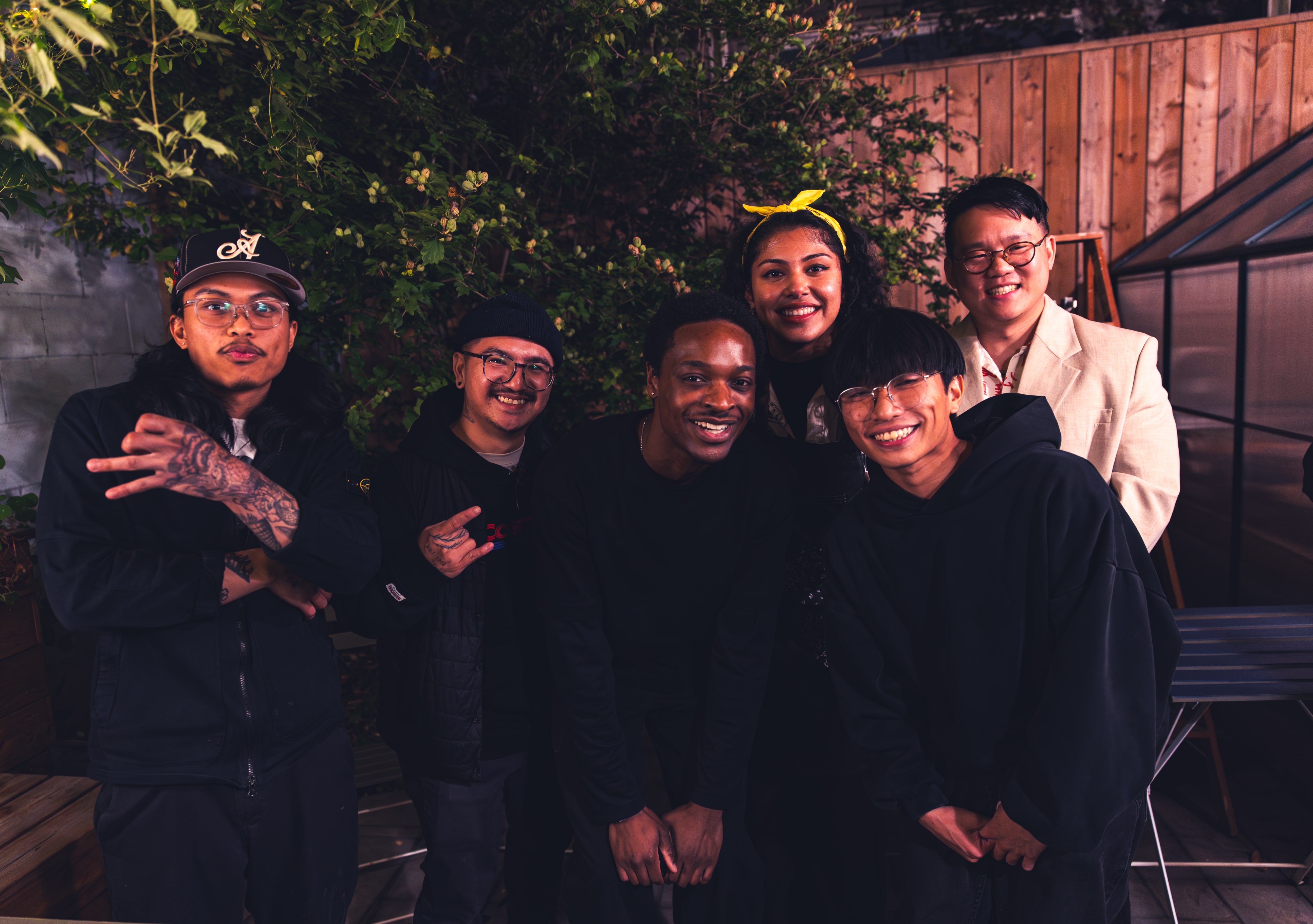
Anam, the grand champion of the fried rice tournament was able to answer a few questions on her culinary journey as well as provide insights on her experience participating in this event.
How did you find out about this event?

2. What is your culinary background?
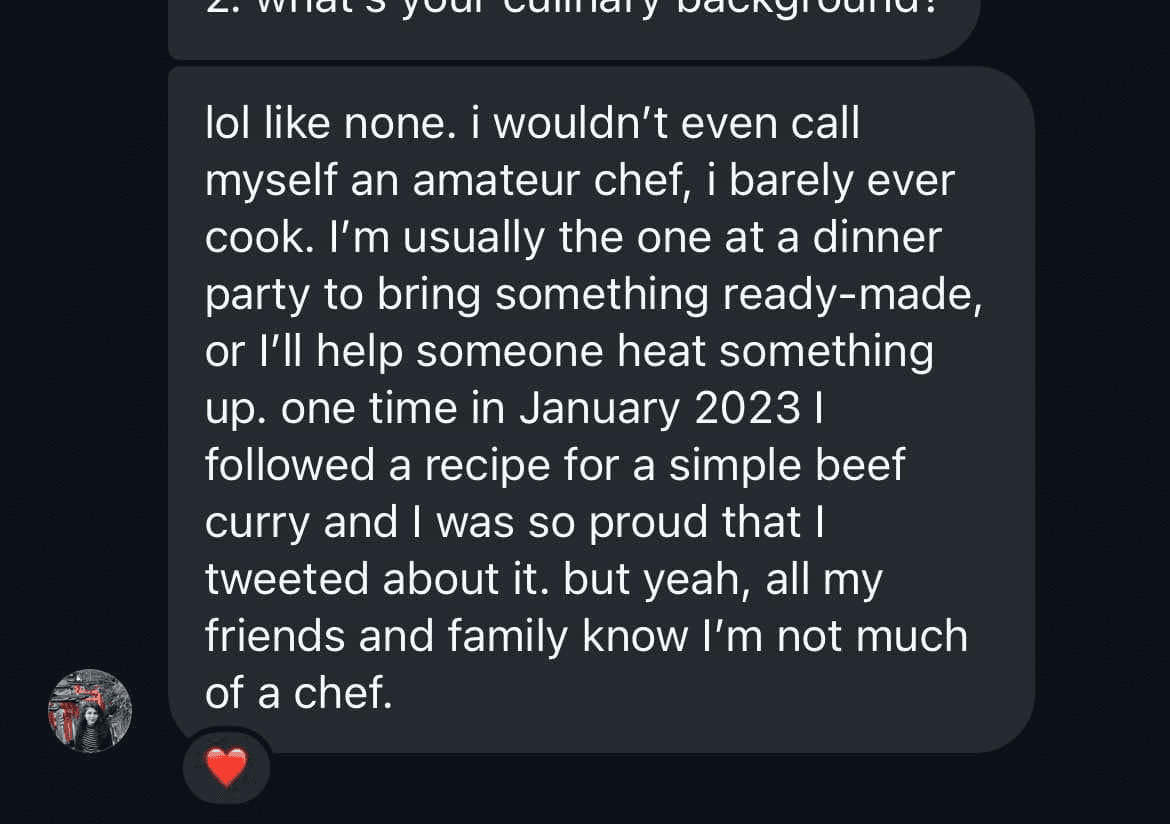
How much did you prepare going into the competition?
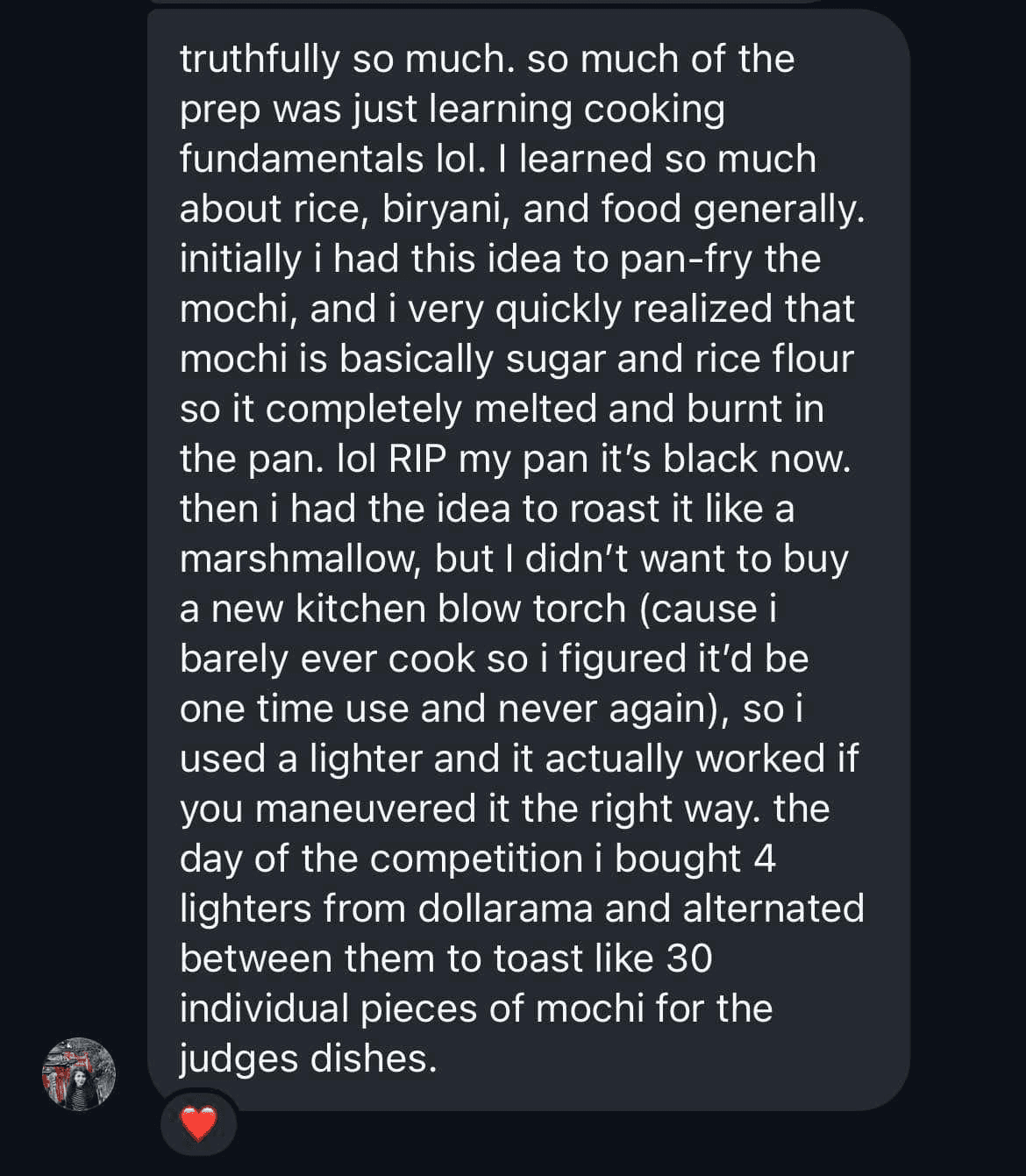
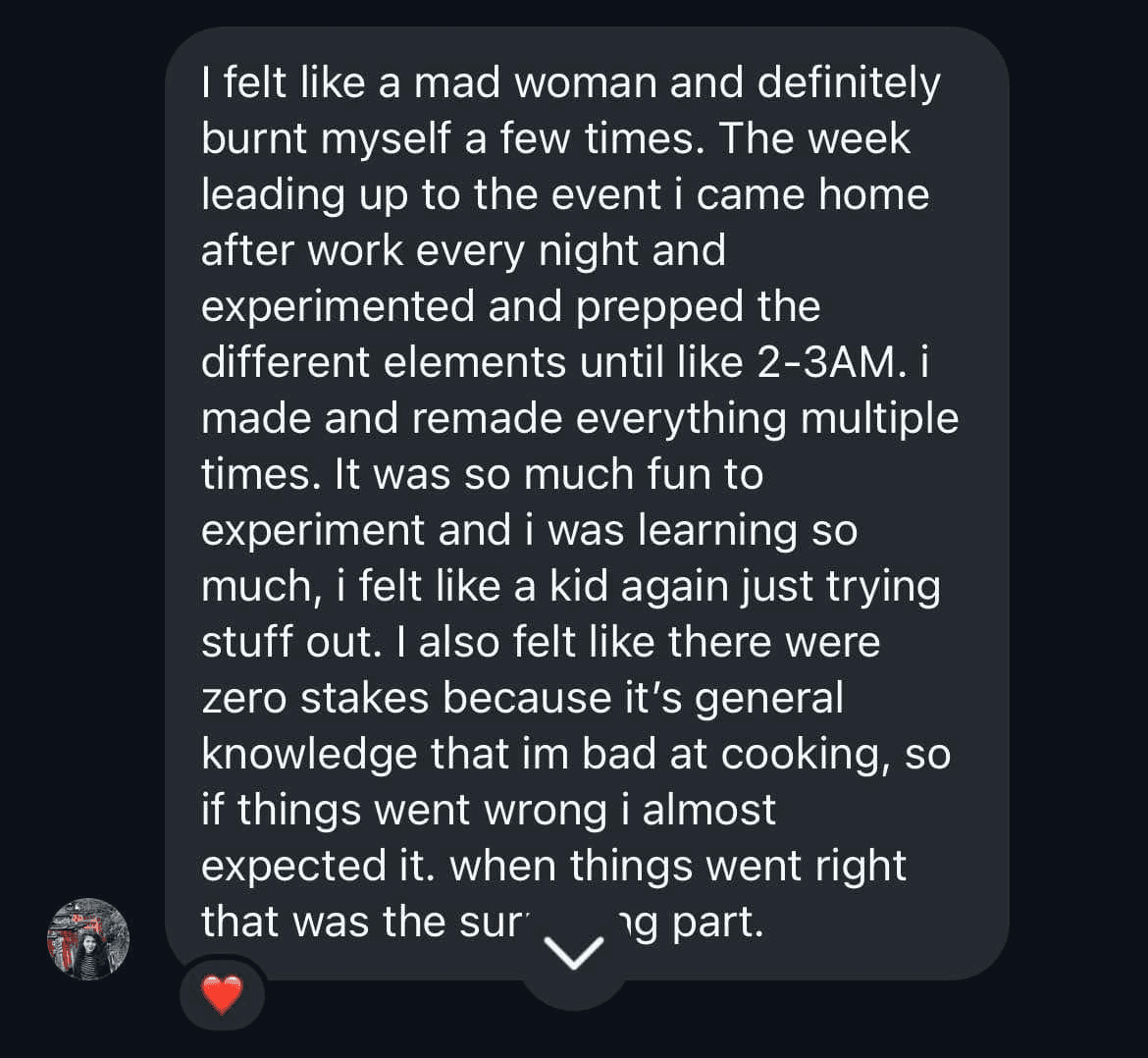
What was your mindset the entire night?

What did you learn?

Closing
Learning #9: There is a lower probability of something fun and exciting happening if you aren't willing to take a chance on someone or something new.
Hopefully after reading this piece, you can see that everything that was done was through someone taking a chance our team. I express my deepest gratitude to all of these individuals for their kindness, time, and energy.
Thank you to our sponsors, judges, and Butter & Blue for making this a reality.
Thank you to all of the chefs for wanting to participate in a fried rice tournament.
Learning #10: Working with the people you respect and admire is incredibly rewarding.
This project would not have been possible if it wasn't for all of the people that helped out and played their role, contributing in as many ways as they possibly could using their unique toolboxes. It's an incredible opportunity to learn more about others, the world, and also yourself.
Thank you Steven, Ken, Marion, Fluppy, and Deandre for your amazing work.
Thank you Novia, Omar, and Flora, for sharing your energy with everyone.
Thank you Malcolm and Michelle for everything.
Learning #11: You can just do things.
These learnings are not exhaustive, but I hope this piece illuminates that the world is more malleable than you may think, and we all have the ability to apply our will onto it.
Oct 22, 2024
Fried rice

Here is a reflection on how the fried rice tournament was brought to life, as well as what I learned throughout the process.
As a disclaimer, this piece is not meant to be interpreted as a "step-by-step" guide on how to host an event. Its purpose is to illuminate how scrappy you can be when creating something, and that if you want to create something, you can just go and do it.
August 25th

On August 25th, I reached out to a couple of friends to ask if they wanted to play soccer at Central Tech Stadium.
Learning #1: I learned that I am really bad at soccer. I officially started calling it "footy" after this evening.
We decide to have post-footy dinner at Maji Curry. Luckily, this moment was captured.

While riding off of our group dynamics and banter, we operate from a perspective of "stunts". My friends and I think a lot about the concept of a stunt and why certain projects and experiences captivate people more than others. We also think a lot about "what is something we'd have fun doing?". At some point during the dinner, I blurt out "fried rice tournament". A spontaneous spit. Not sure if it would land, just something that made me feel something. The table gets excited.
While still eating dinner and laughing over the absurdity of the idea, I begin live tweeting to gather data.

A post-footy dinner at Maji Curry was the genesis of the fried rice tournament.
August 29th
The idea lands.



Learning #2: The people want to see a fried rice tournament.
Data is collected, the idea is a go. Now it's time to act on it.
I scour my mind for the potential venues that can afford this type of experience. Who would be down to host a fried rice tournament? Who is aligned with this type of experience? Who would be fun to work with? What space would impress the intended audience of this event?
I'm a big fan of Baldwin Street. I believe it's a beautiful street that has accomplished something really unique in the Toronto landscape. You have an abundance of amazing cafes checkered off with an abundance of incredible restaurants. The surrounding area consists of the downtown core's larger hospitals, Chinatown, Queen West, Grange Park, as well as easy access from the University of Toronto, OCAD, and TMU. It's a lovely street.
I spent the entirety of 2023 working out of cafes on this street. I became a regular at Butter & Blue and really fell in love with the space and the community it fosters. I've always wanted to work with them.
So I shot them a message.

Learning #3: Just ask.
The venue is confirmed. This is the point of no return.
August 30th
I meet with Natasia, the owner of Butter & Blue. Our conversation forces me to get clear on what the concept is and what would be feasible (and not feasible) in her space. I begin to understand the parameters of the event and what the venue can afford. I also begin ideating on what would go from a conceptual standpoint and what wouldn't. Certain features begin solidifying and I begin saying no to others.
One thing that stood out from this conversation was that it wouldn't make sense for all of the contestants to cook their dishes live. They would have to come with their dishes pre-cooked, and could only be reheated at the venue.
I begin to understand that this event has to take shape around the resources that I have available. There's a difference between striving to build the best thing, and then also working with the momentum and opportunities you have in front of you. I was trying to be efficient and creative with the latter.
The idea of a fried rice tournament becomes clearer.
August 31st - October 3rd
New Builds takes over my life. I am out of commission.
October 4th

The conversation is revived. I'm back in commission after recovering from New Builds.
I ignite a creative direction conversation with my friend Malcolm, whom I deeply admire and respect. I knew that he would be able to deliver on a beautiful poster for the event. We agree to work on the poster together one evening. We end up at Java House and create the sandbox for which the poster's creative direction should live in.
October 5th
I begin collecting more data on what needs to be done to do this event right. I inquire upon several group chats of friends whom I value deeply to collect feedback and ideate on what would make this event fun and meaningful.
I begin receiving feedback that the event needs to have someone cook live for it to go. I receive the sentiment that it falls flat if we cannot see chefs preparing the actual dishes that are being served. People wanted to hear "sizzling". It clicks for me, and I realize that I already knew this all along, but the insight reveals itself once again.
Learning #4: People want to see the process.
I took this data and emailed Butter & Blue back.

At this point, I've yet to secure sponsorship and actual funding for this project to work. With the event expenses piling up, I practice the art of "just asking".

Case Ploeg, Write Your Way Out, Ivan Zhang, and Futureland all reach out confirming that they're down to support the event.

Learning #3 (again): Just ask.
At the exact same time, I've ignited the conversation for a panel of judges. I reach out to my good friend, and tattoo artist Victor, who is also someone I really look up to and inspires me. He founded his own studio called my friends studio, where they host curated events. These experiences range from co-working sessions to cyanotype workshops to private dinners. I look up to him a lot. It was an honour to be able to receive his support and also learn from him on how this event should be conducted.

And that is how I was put into contact with Czar Evan Aboga of xenos.to, and Keanu Francisco of KUSI.
Learning #3 (again): Just ask.
Victor puts me into a group chat with the judges and we begin riffing. I start collecting data from these culinary professionals and learn from them what needs to happen for this event to work. Keanu provides extremely thorough and meaningful feedback. Our conversation also forces me to get even more clear on what this event is and what should be done in principle.



This conversation helped me a lot with refining the idea and getting clear on a lot of the logistical components behind hosting a food event where you want chefs to be serving food to the general public. Keanu illuminates a lot of factors that I hadn't even considered, and wouldn't have thought about, less I had his professional experience. I learned a lot about the Ontario Food Handlers certificate.
Learning #5: Working on anything is simple, but it can be challenging when you're exploring the concept for the first time. Patterns reveal themselves over time.
At this point we've created four tracks for this project;
The venue discussion
The judging panel
The creative direction
The sponsors
As the event name literally has "tournament" in it, it suggests a competitive nature. From my past experience, I've learned that in competitive environments, you need to have a grand prize.
Fortunately, I have an amazing and extremely talented craftsman of a friend whom I really admire and respect. I thought he would be perfect for the job. Steven joins the server.

We begin exploring what the prizes of the evening would look like. This creates the fifth track, prizing.
October 6th
Butter & Blue responds to me. The idea isn't feasible given the venue constraints.

However, I understand the importance of processing feedback from the community and trying to find some middle ground that bridges worlds together. I am able to settle on one live chef cooking in the kitchen by the end of the day.

The idea of a fried rice tournament becomes clearer.
At the exact same time that the venue conversation is coming along, Malcolm creates this beautiful poster for the event.

Learning #6: My favourite way to work is to co-define sandboxes with other people that you admire and whose craft you respect, and then to co-build sandcastles. I feel like I was able to do this with Malcolm effectively.
I begin to recognize that my role in this project would end up being more on the housekeeping side, and I needed someone with the right charisma and energy to spearhead the stream and manage vibes. I recruit Michelle as someone I also admire and respect, and whom I am always confident in when it comes to her ability to MC and spread joy.
Also, on the side, I've reached out to Mike Sunday and asked if he would like to join the judging panel, because I think he's cool.

Learning #3 (again): Just ask.
Things are formalizing and becoming more concrete. I can see the different pieces coming together as well as what areas still need to be explored. I create the most powerful organizational tool that I've ever used throughout my entire life — a group chat.

This group chat would go on to host a fried rice tournament, 11 days from its inception.
October 7th
Given the competitive nature of the event as well as the speed at which it was becoming more and more of a spectacle, we fundamentally knew that it had to be live streamed. Luckily, Michelle has an expansive network for this.


I am put into contact with Marion and Fupply, an incredible broadcasting duo, and the sixth track of live streaming comes to life.
And obviously, we need to capture photos of the evening so that it isn't fleeting. When we initially began ideating on this event, I already had strong imagery in my mind with regards to how it should be captured. It became more clear as we nailed down the venue, figured out more of the granular details, and landed on the idea of treating the event like a family gathering.
Another happy accident here was that I already knew of a photographer that would nail this vision down really well. I've admired his work from afar for the last few months and decided to pull him in.

In about 30 seconds, Deandre was recruited, and the seventh track of photography is born.
Learning #3 (again): Just ask.
October 8th
Excited, I report back to the team.

We begin working on hitting story beats. We thought there was a cool angle to begin revealing the judging panel, which also serves as a way of shouting them out and thanking them for their time. I tap on Malcolm's shoulder.




Malcolm works his magic. I'm grateful for him.
We figure out another logistical component of the event will have to be communicating to guests the allergens and dietary restrictions of the dishes that are being served. Malcolm recognizes this as an opportunity to create a custom card.


More of our bases become covered. We gain broader visibility on all of the moving pieces of this project. We're keeping tabs on important concepts and tightening the vision.
I heckin love Malcolm.
October 9th
Steven is cooking on the prizing.


We've also recruited our good friend Ken, who has a CNC laser cutting machine. We thought it would be cool to make some gifts for our sponsors and judges.


We realized that it's cool to create artifacts that tie back to the event, as they feel limited which creates meaning and value from a storytelling perspective. For these bowls, our idea was to laser print rice flowers onto them.
At this point, we're at 1 week left until the event. The speed and intensity of everything begins to accelerate. We begin navigating multiple tracks on any given day.
October 12th
Level setting for the team and delegating roles.


October 13th
As we are releasing the marketing assets for the judging panel, Mike Sunday announces himself and co-signs Ivan Zhang onto the panel.


And just like that, Ivan becomes a part of the judging panel.


Learning #7: Be open to the vision bending as time unfolds and data is gathered. Play to the energy.
October 14th
At this point, we have about seven tracks going on at the same time.
The venue
The judging panel
The creative direction
The sponsors
The prizing
The live stream
The photographer
While all of this is going on, I am also accepting applications for chefs through a Typeform attached to the Luma event page. I am actively filtering and pseudo-interviewing them to ensure their commitment to the event as well as their overall fit, while considering things such as having an inclusive and diverse lineup.
The eighth track that begins playing out is competitor and vendor management; communicating directly with chefs, providing them a run of show, answering any questions they may have, and supporting them throughout the entire process.
After careful deliberation and direct communication with chef applicants, I am able to confirm the final competitors as well as the vendors for the event. I send an email outlining the instructions for competitors and begin illuminating what the competitive portion of the event will look like.

I begin doing competitor management, which entails checking in on every single competitor and addressing their questions and/or concerns as they arise.
October 15th
The next day, the vendor acceptance email goes out.

Then, I begin doing vendor management.
The custom bowls are completed and packaged (shoutout Myra for her help on this).

I also realize that I probably need somebody else to manage the gate for the event since I would be running around. Personally, I really value the first interaction that happens at any event or gathering that I go to. It really impacts the entirety of the experience, depending on how welcome I feel in that initial moment.
I usually always try to make it a point to be the person that is scanning the Luma QR code, greeting the guests upon arrival, and being that first point of contact. It's my way of personally thanking people for their time, energy, and presence. Unfortunately, I didn't think I would be able to do it this time around given how many things would be going on at once.
With that said, I seek out the warmest and kindest energy that I know of and shoot an ask.

Novia, Omar, and Flora reach out confirming that they are down for the job. I couldn't be any happier.



The organizing team's first in-person sync happens over dinner at BIWON Korean Restaurant. I order the kimchi sausage jjigae, and ask to add ramyun noodles. It costs an extra $3, but it's worth it.
We get clear on all of the remaining deliverables and go through a light run of show. The vision is becoming extensively more clear, and we have a better lay of the land. We wrap up dinner and we proceed to plaster the posters all over the city in the cold.






The posters have been posted. The stunt is shared on social media. We have the sandbox that the event will play within. We don't have all of the granular details mapped out, but we're prepared to figure them out together. Morale is high, and we feel confident.
October 16th
I feel at peace. All of the work that was necessary to get the ball rolling on all of the different tracks has been done. Everyone understands their role. Communication has been consistently constant. The cards are on the table.
Learning #8: I think working on projects (particularly events) feels very analogous to composing and conducting a symphony for an orchestra to play.
Planning the entire event feels like composing. Composing is envisioning all of the different sections of the orchestra. Mapping out who plays where and when.
Hosting the event feels like conducting. Conducting is letting the music unfold on its own and simply managing the dynamic in real-time. Seeing all of the different sections play at once. Guiding the harmonization.
Usually, on the day of the event, I'm kind of on auto-pilot. I'm riding off all of the tailwinds that were created to get us to this point in the first place. The composition is complete, it's just time to conduct. I trust my band, and I know they have my back. Now, my job is to just have fun.
It's usually around this point where I try to remind myself to let go of trying to achieve any specific end result. I assess everything that we've done thus far, and I'm able to generate faith that the event will go towards a direction that we will be happy about.
I'm very hopeful.
October 17th
"You're telling me a shrimp fried this rice?" — Ivan Zhang, (circa 2024)

Catherine's fried rice


Felicia's fried rice

Sophia's fried rice

Nay's fried rice

Kai's fried rice

White Pill's fried rice

Cathy's fried rice




Anam, the grand champion of the fried rice tournament, receiving the fried rice apron, custom made by Steven.









Anam, the grand champion of the fried rice tournament was able to answer a few questions on her culinary journey as well as provide insights on her experience participating in this event.
How did you find out about this event?

2. What is your culinary background?

How much did you prepare going into the competition?


What was your mindset the entire night?

What did you learn?

Closing
Learning #9: There is a lower probability of something fun and exciting happening if you aren't willing to take a chance on someone or something new.
Hopefully after reading this piece, you can see that everything that was done was through someone taking a chance our team. I express my deepest gratitude to all of these individuals for their kindness, time, and energy.
Thank you to our sponsors, judges, and Butter & Blue for making this a reality.
Thank you to all of the chefs for wanting to participate in a fried rice tournament.
Learning #10: Working with the people you respect and admire is incredibly rewarding.
This project would not have been possible if it wasn't for all of the people that helped out and played their role, contributing in as many ways as they possibly could using their unique toolboxes. It's an incredible opportunity to learn more about others, the world, and also yourself.
Thank you Steven, Ken, Marion, Fluppy, and Deandre for your amazing work.
Thank you Novia, Omar, and Flora, for sharing your energy with everyone.
Thank you Malcolm and Michelle for everything.
Learning #11: You can just do things.
These learnings are not exhaustive, but I hope this piece illuminates that the world is more malleable than you may think, and we all have the ability to apply our will onto it.